






On September 28, CFM received the Community and Partner Awards at the Heritage Foundation’s Award Ceremony. After multiple requests, I decided to share the acceptance speech I gave that evening as this edition’s Directors Message. Enjoy and reflect.
On behalf of the Conservation Federation of Missouri, our officers, our Board of Directors, and my dedicated staff, we are honored and humbled to receive the Sacagawea Community and Partnerships Award.
We accept this award on behalf of all the citizens and members that have tirelessly worked, sweated, and dedicated their lives to ensuring the conservation of Missouri’s wildlife and natural resources over our 87 years of existence.

This is about the passion, pride and perseverance of so many conservationists who came before us, those of you in the room tonight, and those who will come after us.
We would not be where we are today without the vision that conservationist’s had back in the 1930s which created that ohso-important Constitutional authority. CFM fights hard every day to protect that legacy. The revolutionary Missouri Model of Conservation which ensued is envied and emulated across the nation, and the world.
I wonder what those leaders and visionaries would think and say today. I have no doubt they would be proud of our outstanding Department of Conservation and would be happy to know that we have the greatest state in the nation to camp, hike, bike, hunt, bird, fish, and recreate outdoors. We owe them a debt of gratitude and must keep things moving in a positive direction.
As the old saying goes, it’s our turn to carry the water. We must carry that water as hard and fast and long as possible, because it gives life to us and the plants and animals we care so much about. And when we get tired from doing that critical work, we should rest, lean on our neighbors and friends, and then go again. We work hard because in Missouri, you have to Show-Me, and because we know our cause is worthy and just.
Like Lewis and Clark, who had a vision and mission, they found a way to get it done. Where would we be today if they had stopped their Expedition when the going got tough?
The three major components of CFM are advocacy, education, and partnerships. Each one of these pillars is embodied in this award.
First, Advocacy. Our critical work in Jefferson City and Washington D.C. is never-ending. We must continually engage with our elected officials. I have pridefully taken the stand on your behalf dozens of times in Senate and House hearings to defend and support the conservation successes that have already been built. We encourage you to speak up and help us be “The Voice for Missouri Outdoors.”
The education pillar is building our future conservation leaders of tomorrow through our Conservation Leadership Corps. These students are the future, and it will soon be their turn to carry the water. We will make them strong, ready and able for future challenges.
CFM staff and members pose for a picture after receiving the award in Springfield. (Photo: Courtesy of CFM)
The partnerships. You heard our Board President Zach Morris talk so brilliantly about our partners. I could not be any more proud of our Conservation community and culture that is continuing to evolve and be relevant and inclusive. Those who know me, know how I believe collaborative success is superior to individual accolades. Together, we will go far.
I want to congratulate the other winners this evening.
Senator Roy Blunt, whom we all know has championed the Recovering America’s Wildlife Act. We will not rest until we get it passed, Senator. Because of RAWA, my great-grandchildren will have cleaner streams and many more species to enjoy in the outdoors. Thank you for decades of public service and support.
To Chip and Teresa McGeehan, both Life Members of CFM, you have given time and energy to numerous facets of conservation in Missouri. You have been outstanding supporters and are two extraordinary human beings.
A big congratulations to Carroll Wilkerson, among many things, has donated so much time, talent and treasure to ensure the Heritage Foundation mission has been accomplished – a job well done, sir.
Mark and Terry Drury, my camo hat is off to you and your entire family. Your passion for the timeless tradition of deer hunting is unparalleled. Using science and innovative media, you have taken the sport to an unprecedented new level.
In closing, on this biggest conservation stage, on the best of nights, with the brightest of stars, and many of my living heroes in this room, I have a challenge for each of you. That challenge is not to let anyone, or anything get in your way of achieving success. And once you have reached your goals, share those outdoor talents and never stop giving back. Because together, with hard work, passion, and perseverance, our conservation legacy will continue, forever.
Tyler Schwartze CFM Executive DirectorYours in Conservation,
Zach Morris - President
Bill Kirgan - President Elect
Ginny Wallace -Vice President
Lisa Allen - Secretary
Bill Lockwood - Treasurer
Tyler Schwartze - Executive Director, Editor
Micaela Haymaker - Director of Operations
Michelle Gabelsberger - Membership Manager
Nick Darling - Education and Communications Coordinator
Joan VanderFeltz - Administrative Assistant
Emma Kessinger - Creative Director
CFM Mission: To ensure conservation of Missouri’s wildlife and natural resources, and preservation of our state’s rich outdoor heritage through advocacy, education and partnerships.



Conservation Federation is the publication of the Conservation Federation of Missouri (ISSN 1082-8591). Conservation Federation (USPS 012868) is published bi-monthly in January, March, May, July, September and November for subscribers and members.

Of each member’s dues, $10 shall be for a year’s subscription to Conservation Federation Periodical postage paid in Jefferson City, MO and additional mailing offices.
Send address changes to: Postmaster Conservation Federation of Missouri 728 West Main Jefferson City, MO 65101
CFM President Zach Morris shares a moment with his dog Orion during a hunt at Fountain Grove Conservation Area. Photo captured by Wildly Creative Co. using a Canon EOS R5 with a 70-200mm 2.8 lens.
Bushnell Doolittle Trailer Enbridge, Inc.

Platinum
.
G3 Boats MidwayUSA Pure Air Natives
Redneck Blinds Rusty Drewing Chevrolet Roeslein Alternative Energy, LLC
Custom Metal Products Forrest Keeling Nursery Learfield Communication, Inc. Lilley’s Landing Resort & Marina
Missouri Wildflowers Nursery Mitico Quaker Windows
Simmons Starline, Inc. St. James Winery
Association of Missouri Electric Coop. Black Widow Custom Bows, Inc. Burgers’ Smokehouse Central Electric Power Cooperative Drury Hotels
Bass Pro Shops (Independence) Bee Rock Outdoor Adventures Blue Springs Park and Recreation Brockmeier Financial Services Brown Printing Cap America Central Bank Community State Bank of Bowling Green

Your
Gray Manufacturing Company, Inc. HMI Fireplace Shop Hodgdon Powder Company, Inc. Missouri Wine & Grape Board NE Electric Power Cooperative, Inc.

NW Electric Power Cooperative, Inc. Ozark Bait and Tackle Woods Smoked Meats
Dickerson Park Zoo Farmer’s Co-op Elevator Association Gascosage Electric Cooperative General Printing Service GREDELL Engineering Resources, Inc. Heartland Seed of Missouri LLC Hulett Heating & Air Conditioning Kansas City Parks and Recreation
Lewis County Rural Electric Coop. Missouri Native Seed Association REMAX Boone Realty Scobee Powerline Construction Sprague Excavating Tabor Plastics Company Truman’s Bar & Grill United Electric Cooperative, Inc.

call (573) 634-2322.

"The Voice for Missouri Outdoors"
Mission: To ensure conservation of Missouri’s wildlife and natural resources, and preservation of our state’s rich outdoor heritage through advocacy, education and partnerships.




In 1935, conservationists from all over Missouri came together to form the Conservation Federation of Missouri (CFM) with the purpose to take politics out of conservation. The efforts of our founders resulted in the creation of Missouri's non-partisan Conservation Commission and the Missouri Department of Conservation (MDC). Since then, CFM has been the leading advocate for the outdoors in Missouri.


Over 100 affiliated organizations Share the Harvest Corporate & Business Partnerships State & Federal Agency Partnerships National Wildlife Federation Affiliate Operation Game Thief Operation Forest Arson David A Risberg Memorial Grants Missouri Stream Team





Conservation Leadership Corps Missouri Collegiate Conservation Alliance Confluence of Young Conservation Leaders Affiliate Summit Scholarships for youth and students Governor’s Youth Turkey Hunt National Archery in the Schools Grants Conservation Federation Magazine






Legislative Action Center

Resolutions to lead change
Natural Resource Advisory Committees Conservation Day at the Capitol Staff and members testify in hearings for conservation and natural resources
Conservation Federation of Missouri began




Wildlife and Forestry Code published
Wildlife and Forestry Act passed First turkey season in
Missouri Department of Natural Resources formed

Operation Game Thief formed


Stream Teams formed
Missouri voters renewed Parks and Soils Sales Tax by 70.8%
Amendment 4 created Missouri's non political Conservation Commission

First deer season since 1937 First hunter safety program formed
Urban fishing program formed in St Louis; first in the nation
Design for Conservation Sales Tax passed
Parks and Soils Sales Tax passed Operation Forest Arson formed
Share the Harvest formed Conservation Leadership Corps formed
Outdoor Action Committee formed

Missouri National Archery in the Schools Program formed

Parks and Soils Sales Tax renewed by voters by the highest percentage to date (80%)

Support our efforts to promote and protect conservation
natural
in our state
receive
magazine six times a year, event information, our bi weekly e newsletter,
the

CFM provides the platform for a diverse group of organizations to have their conservation voices be heard Affiliates have the

for
and promote the mission
receive
their
Become a life member for $1,000 Life memberships are placed in an endowment fund that allows us to continue our work in perpetuity
Business partners will enjoy recognition in each magazine issue along with opportunities to reach and engage with our active membership Ask us about our different Business Partnership levels.

Conservation Federation of Missouri 728 West Main St, Jefferson City, MO 65101
Phone: (573) 634 2322 ~ Email: info@confedmo.org www.confedmo.org
Iget asked all the time if CFM is “just” a hunting and fishing organization. Of course, hunting and fishing are a big part of CFM’s core, and always will be. CFM has worked hard over the last 87 years to protect the future of Missouri’s natural resources and to ensure the rights of all Missourians to enjoy the outdoors. For many, this does mean hunting and fishing, and if it wasn’t for the work of this organization, hunters and anglers would not enjoy the abundant fish and wildlife or widespread public access that Missouri has today.
But as the Voice for Missouri Outdoors, CFM is engaged in many more conservation issues than just hunting and fishing. The work we do is to protect the rights of ALL Missourians to engage in the outdoors, and Missourians connect to nature in many different ways. So, to properly carry out our mission, we should be engaged in all aspects of conservation.
Our mission rests on three pillars: Education, Advocacy, and Partnerships. Let’s break down what that means for our engagement in different areas of conservation.
Education: Our premier education program, the Conservation Leadership Corps (CLC), trains young leaders in conservation policy. We provide leadership training, policy writing experience, and professional development. The program is not limited to students who plan to go into the conservation field as a career, because we believe that anyone, regardless of profession, can be a leader in the outdoor world. The CLC program celebrated its 20th anniversary this year, and over the years our students have gone on to become leaders in the conservation field and beyond.
Advocacy: We engage in advocacy on behalf of all Missourians who are invested in the outdoors. We are committed to protecting everyone’s rights to participate in the outdoors, including hunting and fishing and many other outdoor activities as well. Thanks to the work started by CFM 87 years ago, Missouri’s Conservation Department manages our fish, forest, and wildlife resources without interference from elected politicians. This is a big part of why Missouri is one of the best states for outdoor recreation. We devote a lot of our advocacy efforts to protecting this system from perennial attacks in the legislature, thus ensuring that all Missourians can continue to enjoy abundant natural resources. CFM is also committed to protecting public access to outdoor resources. We will continue to fight against any attempts to sell or defund our state parks, which are some of the best in the nation.

Partnerships: CFM’s strength comes from its partnerships. In addition to our individual members, we are made up of over 100 affiliate organizations. Our affiliates are engaged in every aspect of conservation from hunting and fishing to habitat restoration, hiking, biking, and everything in between. Through our Risberg Memorial Grant, we partner with our affiliates to do great work across Missouri. Past projects include habitat restoration, youth education, and much more.
Through our Share the Harvest program, we partner with hunters, meat processors, and food banks to provide around a quarter million pounds worth of venison to hungry Missourians annually. Thanks to legislation passed in 2020, we have expanded that program to provide jerky snack sticks to more than 25,000 children who participate in the buddy pack program through their school. Other programs you might be familiar with that originated from CFM include Operation Game Thief, Operation Forest Arson, and Missouri Stream Teams.
At CFM, we are committed to being the Voice for Missouri Outdoors on behalf of all Missourians. We are constantly looking for new ways to engage with members and stakeholders. We want to protect our natural resources for the next generation and ensure that all outdoorspeople have a place at the table.
However you participate in the outdoors, whether it’s birding, hiking, biking, canoeing, photography, hunting, fishing, or anything else, there’s a place for you in CFM. Come join us at our annual convention in late February and help make our voice even stronger. In the meantime, make sure to get outside and do what you love. Maybe I’ll see you out there.
Yours in Conservation,
Zach Morris President, CFM





I became a life member of the Conservation Federation of Missouri because I believe in their mission and the work their members are doing to advocate for the outdoors in Missouri.
My love for Conservation comes from the time I spent with my father hunting throughout Chariton County. I am an avid bird hunter and enjoy spending time in the field or a duck blind with my brothers, nephews, and friends. I also love to ride my bicycle and recently completed my bucket list to bike in all fifty states before I hit fifty! These activities, along with hiking and canoeing Missouri’s float streams, fulfill my life.
I am proud to say, I am helping CFM protect these opportunities for all Missourians. I want to be a “Trailblazer” – like Ted & Pat Jones – and help develop the Rock Island Trail corridor for more cyclists to enjoy Missouri’s Rails-to-Trails. I want to work with CFM’s affiliate members to reach their legislative goals – like saving the Eleven-Point River State Park, protecting and expanding the Share the Harvest program, and many more.
Helping create more outdoor opportunities and memories with friends and family is why I will forever support CFM as a lifetime member!

When you purchase a Life Membership with CFM, your money is added to an endowment supporting the administration of the organization in perpetuity. Each year, we draw earnings from the endowment, so your contribution will truly be supporting the CFM for the rest of your life and beyond. This is an important funding source for our Federation.

We hope you will consider joining the over 300
conservationists who have already
the Conservation Federation
a
Missouri by becoming a
www.confedmo.org/join.
Tom & Lisa Boosman, Kansas City
Ann Carletti, Rayville
Bruce Courtney, Saint James John Dorsey, Bland
John Fleck, Chesterfield
John Harwell, Imperial Kayla Rosen, Pacific Daniel Schlegel, House Springs Leonard Smith, Hillsboro McKenna Thompson, Columbia
Keith Voss, Leslie
James Washabaugh, Jefferson City
CFM thanks the 194 members that renewed since our last publication.

In Memory of Gus Degardin
Stewart
In Memory of Lee Crisler,
Mr. and Mrs. Jim Ward
Chad Chandlee
In memory of David Michael Schmittzehe Mr. Kevin Low
In memory of Don and Mary Naumann Mr. Robert Naumann



Let your voice be heard at the Annual Convention. meetings, awards, auctions, and so much more Held at the Lake of the Ozarks
Join CFM for the 7th annual Northwest clay shoot at Boot Hill Shooting Ground in Hamilton.
Join conservationists from across Missouri on the radio for a day of celebrating and supporting conservation and natural resources. From 6 am to 10 am on 96.7 FM or KCMQ.com
Meet fellow conservationists and support CFM at the White River Conference Center next to Bass Pro Shops and Wonders of Wildlife.
Special CFM life member event
Join us for this virtual fundraiser and hear updates about all things conservation.
Take your best shot at the 16th annual Central clay shoot at Prairie Grove Shotgun Sports.
CFM affiliate organizations are invited to network and learn with fellow professionals.
Enjoy a fun and interactive online auction with many great trips and prizes.
Bid on many exciting items just in the time for the holidays.
Event dates are subject to change. Please visit www.confedmo.org or follow us on social media for the most up to date schedule











Missouri and its citizens have a long and storied history of embracing conservation, outdoor traditions, and connecting to the state’s vast and varying natural wonders. We should consider ourselves lucky to reside in a state that embraces the preservation of wild places, connecting with nature, conservation, and providing opportunities for folks to get outdoors and experience all the amazing things the state’s natural resources have to offer.
The ability to take advantage of these outdoor opportunities and experiences can create some unique barriers and challenges for youth and individuals with physical mobility challenges. Creating ways to overcome those challenges was the foundation behind establishing Missouri Disabled Sportsmen in 2008.
Missouri Disabled Sportsmen is a volunteerbased 501(c)(3) non-profit organization that was established by a group of individuals who wanted to provide youth and mobility-challenged individuals with mentored opportunities to participate in and enjoy Missouri’s outdoors.
Its mission is to provide mobility impaired, youth, and terminally ill youth outdoor enthusiasts with hunting, fishing, shooting sports, and outdoor educational opportunities in a safe and inclusive manner throughout the state of Missouri.
Over the years, Missouri Disabled Sportsmen has established a statewide network of 40+ landowners, 250+ mentors/volunteers, and like-minded organizations to help fulfill the mission. The organization also partners with state and federal agencies such as the Missouri Department of Conservation, Conservation Federation of Missouri, Missouri Conservation Heritage Foundation, US Fish & Wildlife, and the US Corp of Engineers to create, support, and facilitate events across Missouri.
Missouri Disabled Sportsmen owns several types of adaptive equipment and a fleet of five trackchairs to assist mobility challenged individuals in the field.
They are also the #1 user of MDC’s statewide fleet of trackchairs which helps to create more opportunities at each event.
Annually the organization offers opportunities to participate in archery & firearm deer hunts, spring turkey hunts, dove hunts, waterfowl hunts, rabbit hunts, sport shooting, 3D archery, fishing, and outdoor education-based events around the state. Their state-wide network of volunteers also helps facilitate one-off opportunities in their local areas and provides guides or mentors for disabled managed hunts held throughout the state.
“Our goal is to make every event a positively impactful experience for the participants and volunteers alike,” said Pete Eisentrager, Board Chairman of Missouri Disabled Sportsmen. “One of the most impactful things we see on a consistent basis is mobility impaired individuals forgetting about their daily challenges while participating in our events, along with all the smiles and laughter that always occurs.”
Anyone looking to participate, volunteer, host or support an event can contact Missouri Disabled Sportsmen via social media, email at missouridisabledsportsmen@gmail.com or visit their website at missouridisabledsportsmen.org .
Pete Eisentrager Board PresidentAnglers of Missouri Association of Missouri Electric Cooperatives
Bass Slammer Tackle Burroughs Audubon Society of Greater Kansas City Capital City Fly Fishers Chesterfield Citizens Committee for the Environment
Columbia Audubon Society
Conservation Foundation of Missouri Charitable Trust Deer Creek Sportsman Club Duckhorn Outdoors Adventures Festus-Crystal City Conservation Club Forest and Woodland Association of Missouri
Forest Releaf of Missouri
Friends of Rock Bridge Memorial State Park Gateway Chapter Trout Unlimited Greater Ozarks Audubon Society
Greenbelt Land Trust of Mid-Missouri Greenway Network, Inc.
James River Basin Partnership L-A-D Foundation
Lake of the Ozarks Watershed Alliance Land Learning Foundation Legends of Conservation Little Blue River Watershed Coalition
Magnificent Missouri
Mid-Missouri Outdoor Dream
Mid-Missouri Trout Unlimited Midwest Diving Council
Mississippi Valley Duck Hunters Association Missouri Association of Meat Processors Missouri Atlatl Association Missouri B.A.S.S. Nation
Missouri Bird Conservation Initiative Missouri Birding Society Missouri Bow Hunters Association
Missouri Caves & Karst Conservancy Missouri Chapter of the American Fisheries Society Missouri Chapter of the Wildlife Society Missouri Coalition for the Environment Missouri Conservation Agents Association Missouri Conservation Heritage Foundation Missouri Conservation Pioneers
Missouri Consulting Foresters Association Missouri Disabled Sportsmen Missouri Ducks Unlimited- State Council
Missouri Forest Products Association Missouri Grouse Chapter of QUWF Missouri Hunter Education Instructor's Association
Missouri Hunting Heritage Federation Missouri Master NaturalistBoone's Lick Chapter Missouri Master NaturalistGreat Rivers Chapter Missouri Master NaturalistHi Lonesome Chapter
Missouri Master NaturalistMiramiguoa Chapter Missouri Master NaturalistOsage Trails Chapter Missouri Master NaturalistSpringfield Plateau Chapter
Missouri National Wild Turkey Federation Missouri Native Seed Association Missouri Outdoor Communicators Missouri Park & Recreation Association Missouri Parks Association Missouri Prairie Foundation
Missouri River Bird Observatory Missouri River Relief
Missouri Rock Island Trail, Inc. Missouri Rural Water Association Missouri Smallmouth Alliance Missouri Society of American Foresters
Missouri Soil & Water Conservation Society-Show-Me Chapter Missouri Sport Shooting Association
Missouri State Campers Association
Missouri State Parks Foundation
Missouri Taxidermist Association
Missouri Trappers Association
Missouri Trout Fishermen's Association
MU Wildlife & Fisheries Science Graduate Student Organization
Open Space Council of the St. Louis Region
Ozark Chinquapin Foundation
Ozark Fly Fishers, Inc.
Ozark Land Trust
Ozark Riverways Foundation
Ozark Trail Association
Ozark Wilderness Waterways Club
Perry County Sportsman Club
Pomme De Terre Chapter Muskies
Quail & Upland Wildlife Federation, Inc. Quail Forever & Pheasants Forever River Bluffs Audubon Society
Rocky Mountain Elk Foundation South Side Division CFM
Southwest Missouri Fly Fishers St. Louis Audubon Society
Stream Teams United Student Air Rifle Program
Tipton Farmers & Sportsman's Club Tri-Lakes Fly Fishers
Troutbusters of Missouri United Bow Hunters of Missouri Watershed Conservation Corps
Wild Bird Rehabilitation
Wild Souls Wildlife Rescue Rehabilitation Wonders of Wildlife World Bird Sanctuary Young Outdoorsmen United







Owned by the members they serve, Missouri’s electric cooperatives do more than provide reliable and affordable electricity. They are active in their communities, concerned for the wellbeing of their neighbors and devoted to the rural way of life that makes the Show-Me State a special place to live, work and play. Missouri’s electric cooperatives are dedicated to protecting the land, air and water resources important to you and your quality of life. Learn more at www.amec.coop.
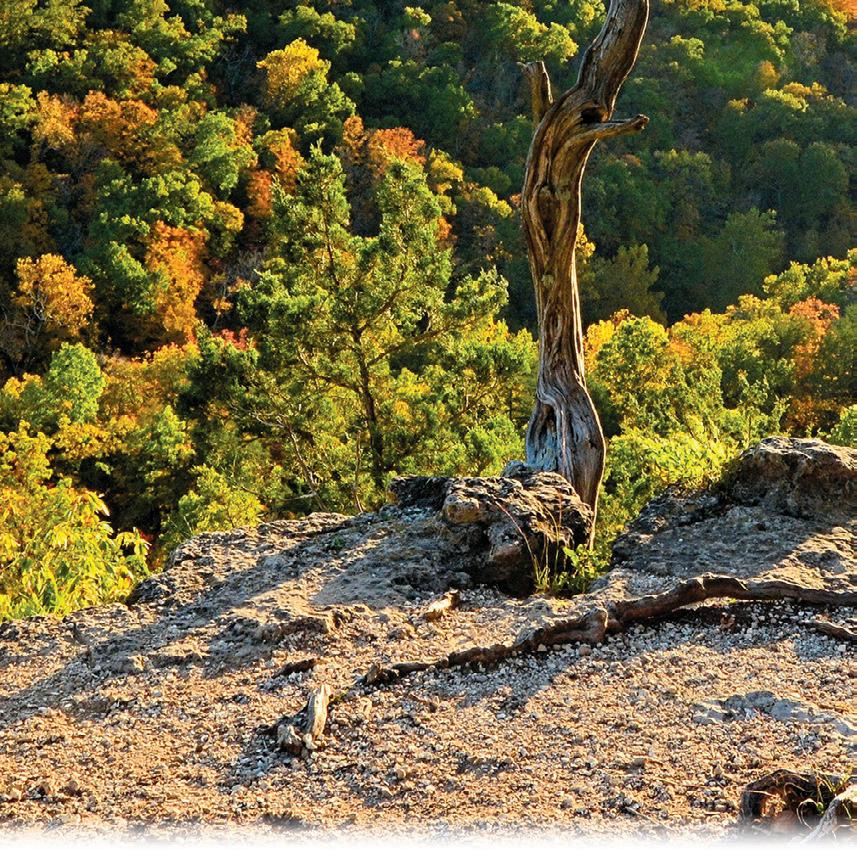




In July this year, a request was made for CFM Officer and Board Nominations for the 2023 election. Five officer nominations and seven at-large nominations were received. The Nomination Committee reviewed and accessed each nominee to rank for each position and create a slate of candidates. In January 2023, CFM members will vote electronically. The following nominees are the candidates:
At-Large Board positions (4 open positions)
• Ralph Duren
• Steve Jones
• Josh Lane
• Jim Low
• Benjamin Runge
• Ryan Verkamp
• Colton Zirkle
Executive Committee (2 open positions)
• Lisa Allen
• Steve Jones
• Tom Westhoff
Secretary (1 open position)
• Benjamin Runge
• Ryan Verkamp
Members, you have a call to action: VOTE!
CFM members can read about the roles of each position at confedmo.org/boardelections/ as well as the preferred (but not required) qualifications and experience for each. The nominee’s bios and video on CFM’s website will give voters a chance to hear nominees express their views.
Sample Ballot: Voting in this election will take place electronically during the month of January. The exact format is still in development; however, it will look something like the following.



Secretary (vote for one): Benjamin Runge Ryan Verkamp
Executive Committee (vote for two): Lisa Allen Steve Jones Tom Westhoff
At-Large Board members (vote for 4): Ralph Duren Steve Jones Josh Lane Jim Low Benjamin Runge Ryan Verkamp Colton Zirkle
The Conservation Federation of Missouri (CFM) staff continues to grow with the addition of Nick Darling as Education and Communications Coordinator. Darling will be charged with managing the Conservation Leadership Corps (CLC), the Missouri Collegiate Conservation Alliance (MCCA), and continue the development of the Young Professionals group. Also, he will manage CFM's website and social media accounts.
"We are excited to add Nick to our talented team here at CFM. His outdoor passions and experiences, coupled with his desire to make a change in conservation, make him an excellent fit," said Tyler Schwartze, CFM Executive Director. "Our CLC program is an amazing opportunity for our conservation-minded students to take hold and be the voice of the next generation. Nick is a great fit to grow our young leaders and help them reach their full potential."
Nick most recently worked as a Park Interpreter at Garden of the Gods Park in Colorado Springs, Colorado, leading guided walks and other programs for visitors from across the globe. This position helped him refine his skills as a communicator and gain experience working with a diverse audience. Nick received a B.S. in Wildlife Conservation and Management from Missouri Western State University, during which he interned with the Missouri Department of Conservation’s Outreach and Education division, and was involved with the university’s student chapter of The Wildlife Society.
“I am so excited to be joining CFM as the Education and Communication Coordinator. I believe Missouri has some of the best natural resources in the world, and it is amazing to be a part of an organization that advocates for these natural resources and helps people connect to them,” said Darling. “It will be great working with the CLC and being able to help those who are passionate about conservation develop leadership skills that will allow them to thrive in their future careers, no matter what the field is.”
Nick was born and raised in Missouri and spends his free time backpacking, birding, hunting, and enjoying Missouri’s waterways. He also hopes to learn more about Karst topography and explore the state’s amazing cave systems.






Shelter Insurance® is a proud sponsor of Share the Harvest & the Conservation Federation.


Contact your local Shelter agent to insure your auto, home, life, and all your hunting & fishing gear. Find an agent near you at ShelterInsurance.com.

The 9th Annual Affiliate Summit was held on September 8 and 9, 2022, in Jefferson City at the Association of Missouri Electric Cooperatives building. Conservation Federation of Missouri (CFM) welcomed representatives from 27 affiliate organizations. After hosting the event as a hybrid last year, and exclusively online the year before, it was entirely in-person this year.
The workshop provided affiliates with various information, including David Risberg Memorial grant opportunities, legislative training, and the CFM affiliate election process.

In addition to the informational sessions, the event allows affiliates to learn more about the Conservation Federation of Missouri’s history. A national guest speaker, Katie Lord, joined on Friday morning to share fundraising advice based on donor emotions.
Michelle Gabelsberger, the Membership Manager with CFM, who works with each affiliate under the CFM affiliate umbrella, said, “The most abundant resource that we possess in the conservation area is the passion and knowledge, plus the greatest valuable resource of all is collaboration. That is what this summit brings to the forefront.”
“We would like to thank every one of our affiliates, board members, volunteers and staff that took the time to join us at this year’s Summit. It is always great to visit and learn alongside the valuable partners across the state executing their vital missions”, said Tyler Schwartze, CFM Executive Director.
Thank you to our sponsors: Bass Pro Shops, Missouri Elective Cooperatives, Missouri Conservation Heritage Foundation, and the National Wildlife Federation.
Attendees from this year’s Affiliate Summit include:
• Forest and Woodland Association of Missouri
• Friends of Rock Bridge Memorial State Park
• Association of Missouri Electic Cooperatives
• LAD Foundation
• Land Learning Foundation
• Missouri Atlatl Association
• Missouri Bird Conservation Initiative
• Missouri Chapter of the American Fisheries Society
• Missouri Conservation Pioneers
• Missouri Department of Conservation
• Missouri Grouse Chapter
• Missouri Hunting Heritage Federation, Inc.
• Missouri Parks Association
• Missouri Park & Recreation Association
• Missouri Prairie Foundation
• Missouri Trappers Association
• MO Hunter Education Instructors Association
• National Wild Turkey Federation
• National Wildlife Federation
• Ozark Fly Fishers
• Ozark Riverways Foundation
• Ozark Trail Association
• Pheasants Forever & Quail Forever in Missouri
• Soil and Water Conservation Society
• St. Louis Audubon Society
• Stream Teams United
• Wild Souls Wildlife Rescue and Rehabilitation
Michelle GabelsbergerThe conservation Federation of Missouri (CFM) is now accepting nominees for the Conservation Achievement Awards. These nominees should be Missourians who exemplify all that CFM stands for, and have been bettering Missouri’s outdoors through personal efforts throughout the year 2022. Those who win the Conservation Achievement Award will be recognized at the CFM Annual Convention in March 2023.

Conserving our air, water, soil and wildlife resources is an ongoing challenge that requires a continuing commitment by all citizens. Many people have made outstanding personal efforts toward some aspect of conservation, either individually or as part of an organization. Through these awards CFM seeks to give them the recognition they deserve. If you know someone who has done something special to aid conservation in Missouri, we invite you to nominate them for a Conservation Award.
Conservation Awards are presented in the following categories:
• Conservationist of the Year
• Conservation Communicator of the Year
• Forest Conservationist of the Year
• Air Conservationist of the Year
• Professional Conservationist of the Year
• Conservation Educator of the Year
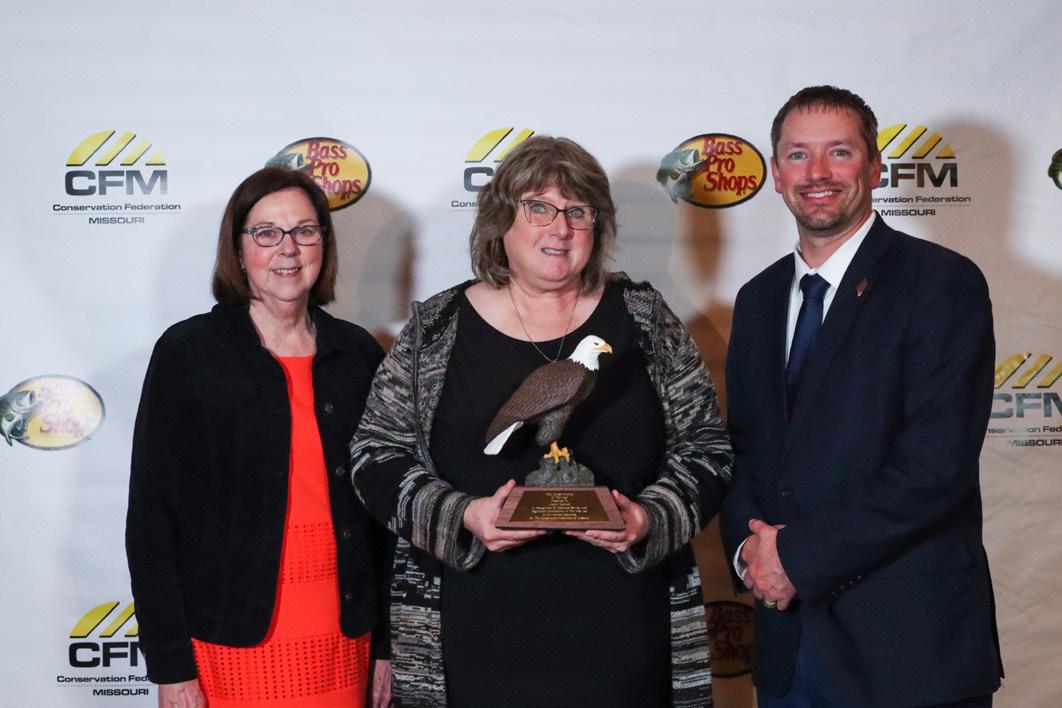
• Water Conservationist of the Year
• Youth Conservationist of the Year
• Hunter Education Instructor of the Year
• Wildlife Conservationist of the Year
• Soil Conservationist of the Year
• Conservation Organization of the Year
• Conservation Legislator of the Year
• Outstanding Lifetime Achievement
The nomination form can be found on our website at confedmo.org/awards/. This also includes additional information on each award category. For questions, please call our office at (573) 634-2322.
Send nominations to Micaela Haymaker at mhaymaker@ confedmo.org or mail to CFM, 728 West Main St., Jefferson City, MO 65101. The deadline is December 31, 2022.
Our Conservation Leadership Corp students gathered the weekend of September 1618 at Camp Clover Point in Lake of the Ozarks State Park. After being accepted into the program last spring, the Fall Workshop was the first time for the whole class to come together, and everything went off without a hitch. Students returning to the program were ready to take the new students under their wings, but the first-year students were well prepared and did not need much guidance.
At the workshop, students are encouraged to reflect on what draws them to the outdoors. One of the ways this is accomplished is through their silver compass. Students chose from a list of over 80 quotes, picking the one that resonates with them the most. Examples include “When one tugs at a single thing in nature, he finds it attached to the rest of the world,” by John Muir as well as Aldo Leopold’s, “A conservationist is one who is humbly aware that with each stroke [of the axe] he is writing his signature on the face of the land.” Students carry a notecard with their silver compass written on it with them throughout the weekend. It can help start a conversation with a new acquaintance, and help remind them what our natural recourses mean to them.
The Conservation Leadership Corp has one main objective, to make leaders out of high school and college aged students that share a passion for the outdoors. While many of the students are interested in future careers in conservation, it is not necessary to be accepted into the program. We want to better equip them to influence policy and advocate for our natural resources in their future careers, whatever that may be.

One of the ways this is accomplished is by engaging the students in CFM’s resolution process. Each student comes to the Fall Workshop with a couple of ideas on potential resolutions, and after a few hours collectively brainstorming, narrow it down to the most important ones.
After splitting up into groups to work on the resolutions most important to them, much of the weekend is spent determining the direction to take with the resolution and developing a draft. After leaving the workshop the students continue refining their resolutions, reaching out to relevant resource professionals for input.
However, the resolutions aren’t all the students work on during the weekend. There are several leadership and team building activities throughout the workshop. Students are able to spend free time bonding with one another, and resource professionals are invited to the workshop to help guide the students and for some networking opportunities. There was even a hands-on session on learning atlatl throwing!
As students leave the workshop, they exchange contact information with one another in order to further collaborate on the resolutions. While there are volunteer opportunities and hands on learning experiences for the students to attend throughout the year, this will be the last time the whole group is together in one place until CFM’s convention in February. In the time being, they will be hard at work perfecting their resolutions.
Nick DarlingAlong history of popularity – both as a hunting activity and as a target-shooting pastime – has earned archery special legislative designation in Missouri.
On Monday, Aug. 8, members of Missouri’s legislature joined staff from the Missouri Department of Conservation (MDC), Conservation Federation of Missouri (CFM), Bass Pro Shops Outdoor World, the Archery Trade Association (ATA), and a number of young archers from across southwest Missouri to recognize archery’s designation as Missouri’s official state sport. A brief ceremony was held at the Archery Hall of Fame and Museum at Bass Pro Shops in Springfield.

“Anyone can participate at any level, regardless of age, size, or physical ability,” said Missouri Rep. Tim Taylor (R-District 48) who introduced this initiative earlier this year. As a lifelong bowhunter, long-time archery instructor for Cooper County’s 4-H program, and an instructor for the Missouri National Archery in the Schools Program (MoNASP), Taylor comes by his love for archery naturally.
“We greatly appreciate Governor Parson and the Missouri General Assembly’s support for recognizing archery as the Official Sport of Missouri,” said MDC Director Sara Parker Pauley. “A sincere thank you to Representative Tim Taylor for introducing the bill and for his support and interest in conservation and archery.”
Missouri has a significant connection to bowhunting and the archery industry. One of Missouri’s most significant ties to archery – the compound bow – is a Show-Me state connection to the sport that is well-documented, but is somewhat forgotten. Missourian Holless Wilbur Allen, Jr., who lived in Kansas City and later in Billings, took a bow that had experienced little design change for thousands of years and, by adding pulleys and extra cables to the limbs of the bow, created a type of bow that revolutionized the archery industry throughout the world. Allen received a patent for his compound bow in 1966. He then collaborated with bowmaker Tom Jennings to mass produce the compound bow – the type of bow that’s most popular with today’s archery hunters and target shooters.
Another highlight of Missouri’s archery tradition is the Hoyt Archery Company that started in 1931 in St. Louis. The business earned a reputation for building high-quality cedar arrows and remarkably straight-shooting stickbows. Earl Hoyt Jr. was an engineer who turned his skills into a business built around archery and bowhunting.
Innovations that emerged from the partnership can be found in today’s high-tech compound bows. Hoyt’s Pro Medalist bows dominated the scene in four Olympic Games and were adopted by archers from many foreign countries, as well. In 1977, Earl Hoyt Jr. received the National Archery Association’s highest award – the Thompson Medal of Honor.
MoNASP is another sign of archery’s popularity in the Show-Me State. MoNASP is coordinated through the Missouri Department of Conservation and the Conservation Federation of Missouri in partnership with participating schools and numerous supporting organizations throughout the state. Since it began in Missouri in 2007, MoNASP has been introduced to 960 Missouri schools. MoNASP is an affiliate of NASP (National Archery in the Schools Program) and promotes education, self-esteem, and physical activity for students in grades 4-12 through participation in the sport of archery.
Today, there are more than 202,000 archers participating in the fall tradition of bowhunting; harvesting nearly 60,000 deer annually. “Archery has a long, rich history, said Dan Forster, ATA vice president and chief conservation officer. “Missouri’s recognition of archery as the state’s official sport pays appropriate tribute to all those before us and to the hundreds of thousands of active bowhunters and target archers in the Show-Me State who participate in and advance this timeless and shared passion.”
I've volunteered with various central Missouri nonprofit organizations for years, including helping organizations with their foreign exchange student programs. Several central Missouri groups bring high school students from other countries for a year of school in the United States. Students stay with host families and my role was to introduce these foreign exchange students to Missouri outdoor activities.

Typically, one of the more requested activities by exchange students was to learn to shoot guns. The opportunity to shoot firearms in their home countries was limited, plus they heard stories and tales about the availability of firearms in the United States. Basically, the students were curious about firearms. In the years I've taught foreign exchange high school students to use a firearm, not one had previously fired a gun. Most were fascinated with pistols.
I have a safe place on our 40 acres in Moniteau County to fire guns at a variety of targets. Typically, I started with the standard safety protocols like hearing protection, operation of the safety, loading and gun handling. I usually began the shooting with a shotgun at clay targets, and after a few rounds, most of the students could eventually hit a clay bird. In recent years, these teenagers brought their cell phones and immediately posted their experiences on the Internet for people in their hometowns to see. The most challenging safety protocol to teach was setting the safety on after firing the gun and I had to watch the students like a hawk to make sure they pushed the safety button.
I used .22's for rifle shooting because the recoil is not intimidating for new shooters. Plus, I could use targets that spun or fell over, making hits more noticeable and fun, especially for cell phone videos. But the pistol shooting was typically the most fascinating and the hardest to teach. These students had watched too many movies with the wrong way to hold and fire a pistol. At the end of these shooting sessions, the students all liked to have their pictures taken with their cell phones while holding guns. The more the better.
I only took one exchange student rabbit hunting because he spent enough time with me practicing gun handling skills and I was comfortable with him carrying a gun. He walked along with me without a gun several times to learn about the beagles and position himself to make a shot. Most first-time rabbit hunters rarely get a rabbit because they are too slow to react, but this student managed to get a rabbit with his first shot. Other students wanted to go hunting but were not able to devote time to preparation.
One of the more memorable shooting sessions was with a group of young adult German businessmen and women who were touring Missouri for a month, learning about business practices. One of their last activities was a fish fry and clay bird shooting at our place. Everyone tried the shotgun a few times, and several managed to hit a clay bird. Then the last man picked up the shotgun. I knew immediately he was familiar with firearms because he checked the safety first. He turned the first clay bird to dust, followed by the second and third.
I threw two clay birds simultaneously and he got them both. Finally, I gave him an automatic shotgun, and I released four clay birds two at a time, and he got all four. The other people were just as amazed as I was. Then I released four clay birds all simultaneously and he blasted each one. This man may have been a better clay bird shooter than me, although we didn't have time for a formal match to settle the issue, which was probably best. It turned out he was recently discharged from the German army and was an expert with anything that had a trigger.
Fishing is another activity I helped many of the exchange students learn. In the years I took foreign exchange students fishing, only a few had fished in their home country. I live less than 8 miles from the Missouri River, which is fascinating and mysterious for people unfamiliar with big rivers.

I put out several trotlines baited with live fish the evening before one large group of students arrived at the Marion Access north of Jefferson City. There were almost two dozen students, so I arranged for two more boats.
Checking the trotlines was an amazing experience for the students. None had even been in a motorboat and they all wanted to drive it, which was prohibited by the exchange student rules. Lifting a trotline with wiggling live bait was generally shocking to the students. Seeing a big flathead or blue catfish on the line was even more shocking.
I knew they would be even more surprised by the Asian carp jumping into the boat. So I drove the boat downstream from a wing dike where I knew large numbers of Asian carp were located. Under the water at this location were old wooden pilings that supported the first dikes in the river installed over 80 years ago. But these old wooden posts were well under the water and probably why the Asian carp used this spot.
I drove the boat in a tight circle which made the carp jump and several landed in the boat flopping around. There was screaming and I knew there would be. But while the students were trying to avoid the fish, I neglected a basic physical principle of boating.
There were nine more people in my boat than I typically had on board and the boat became stuck on one of the old wooden underwater posts because the additional weight of the people increased the draft. I couldn't go forward or backward. The boat would just spin on top of the post. This was a level one problem. I was thinking the students would have to get out and hang onto the side of the boat when another boat came down the river.
I stood up, waved my arms and the other boat cruised up to my boat. It was driven by a commercial fisherman I knew, and I could tell by his smile that he was going to offer some caustic and disparaging remarks about my boat handling skills. Only about half of the students had reasonable English-speaking skills but they all understood what this man was saying plus they all had their cell phones out to record some very colorful rural Missouri language. Eventually, it stopped and the students loaded into the other boat. As soon as the last student was out of my boat, it floated off the post. The commercial fisherman spun his boat in tight circles and more carp jumped into his boat. These fish had to be transferred into my boat because I use the Asian carp as cut bait. None of the students would pick up a flopping carp. The fisherman offered some final scathing remarks before leaving, which were also recorded on all the cell phones.
On several occasions, I took students pole and line fishing on the Missouri River. This type of fishing takes some patience and I would generally have trotlines out for a change of pace. I took one student from Brazil who spoke almost no English plus my Portuguese was very rusty. It is hard to teach someone how to fish with stink bait on the bottom of the river using sign language. I eventually learned he was much better at reading English than speaking it. I would write out instructions and draw pictures on an old envelope which worked fine, and he was thrilled with the catfish he caught.
One of the more memorable experiences with the exchange students was with a group of girls who were not interested in shooting or boating. Instead, they wanted to learn how to make American-style dessert pies. I have a significant and well-deserved reputation in central Missouri as a master pie maker, so I naturally volunteered to help with this task. Mrs. Urich and I have traveled to many European countries, and for the most part the pies are terrible. Europeans are excellent at pastries and cakes, especially jam cakes. But bakers have not learned how to make a good, flakey crust plus the filling is generally not great either.
I put on a pie baking seminar at our house. Since we have an apple orchard, I showed the students how to make an apple pie. This included mixing the crust ingredients, rolling out the crust on a chilled marble rolling board and pre-baking the bottom crust to keep the filling from making the crust soggy. Each student got to take a baked apple pie home to their host family.
Much to my surprise, in their final reports on their yearlong experiences in Missouri, these students cited the pie baking as a highlight. So hopefully they will spread this pie baking knowledge across their home countries, which will grow and Americans will finally be able to get a nice piece of pie on the European continent.
My years of introducing foreign exchange students to outdoor activities taught me how fortunate Americans are to have access to outdoor recreation. Most of the students will likely never go fishing again and certainly will not go hunting or even hold a firearm again. The availability of public land and access to public waters is not an option for most of these students and is a privilege that Missourians need to protect.
David Urich(Cover) Exchange students on the Missouri River after checking trotlines. (Photo: David Urich)
(Right) David Urich with two exchange students, one from Columbia and the other from Switzerland, holding apples pie they baked during a pie baking seminar. (Photo: David Urich)
(Top) Brazilian exchange student on his first hunting trip successfully harvesting a rabbit with his first shot. (Photo: David Urich)
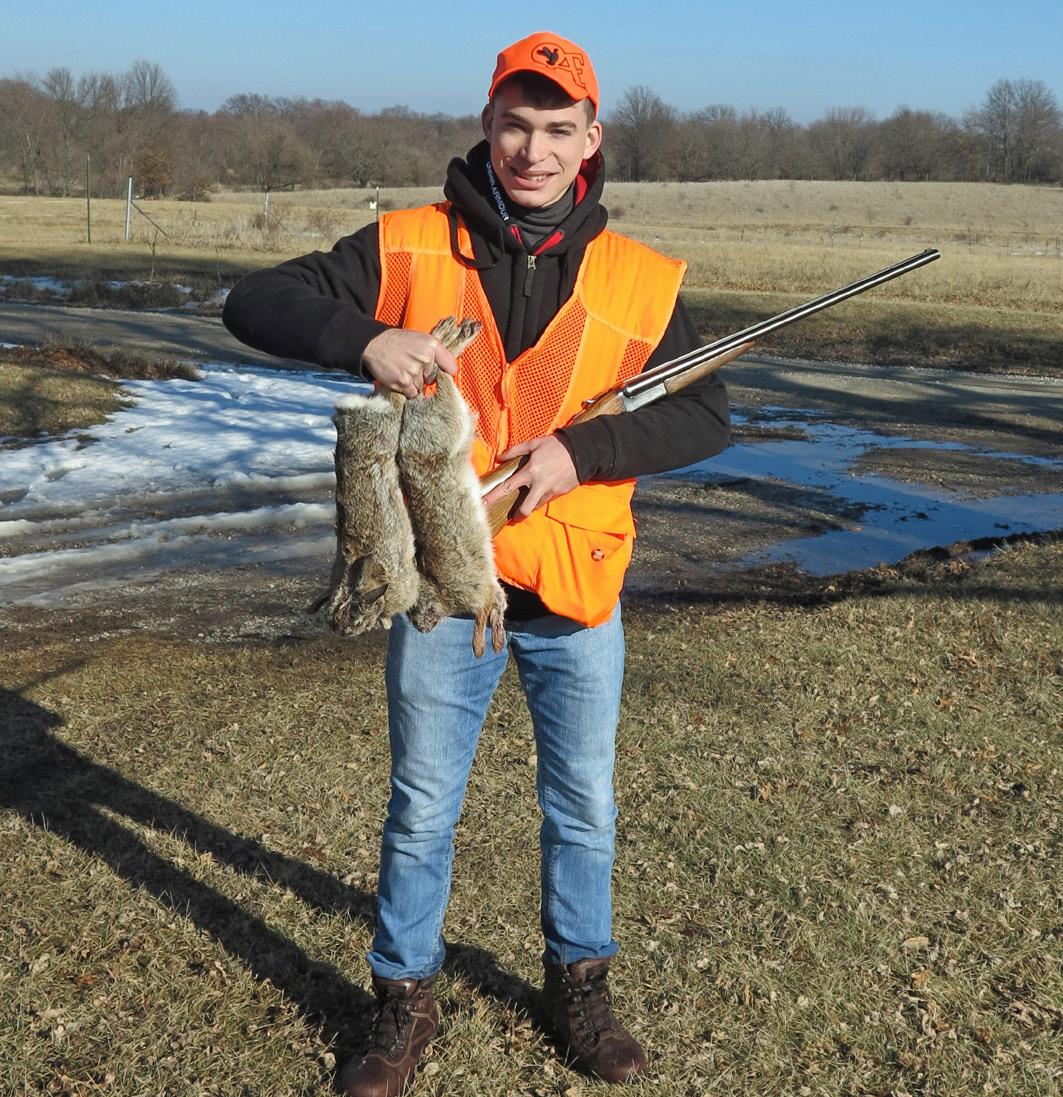
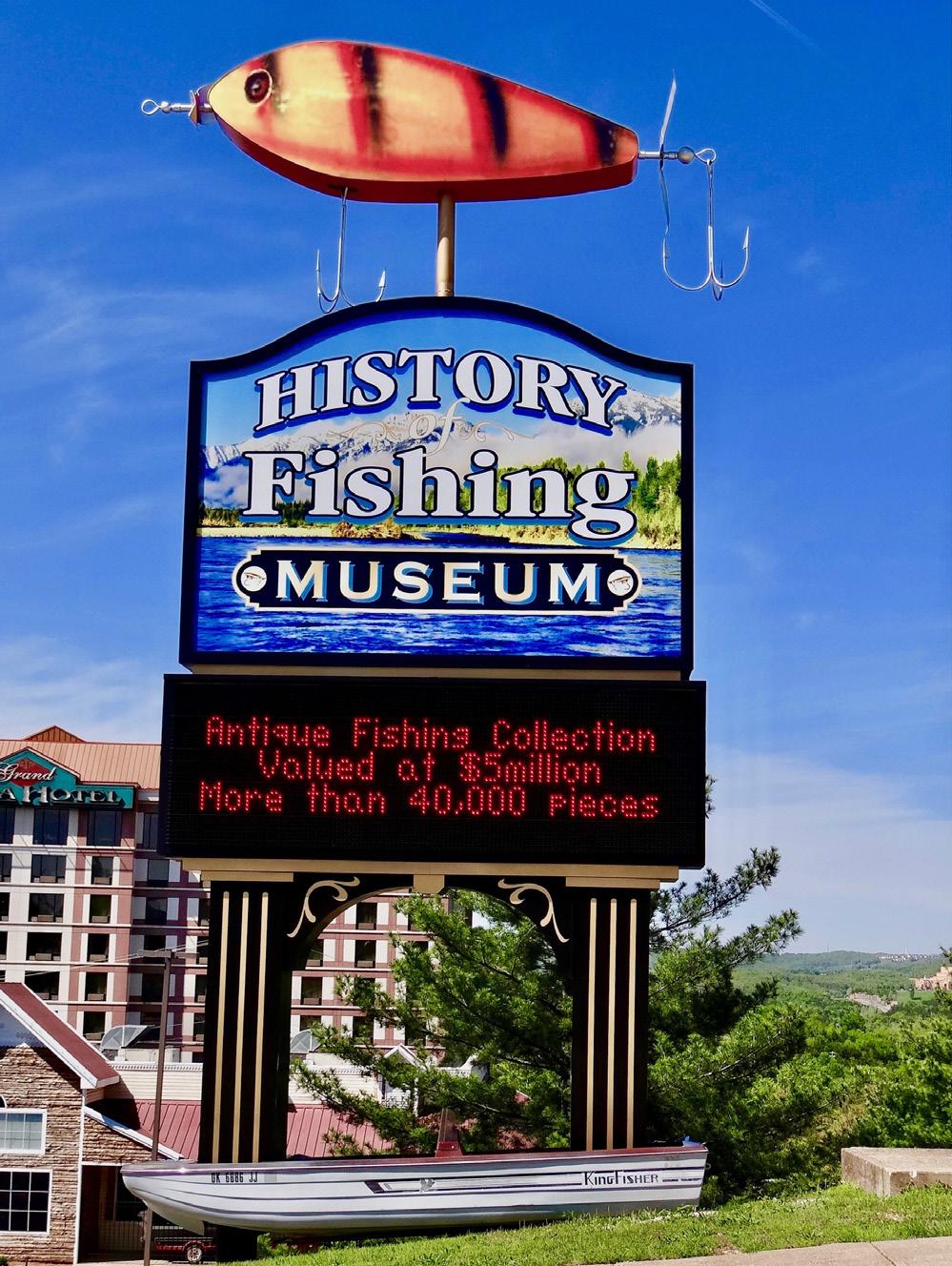
Ithink I can safely say we all love visiting Branson. Everywhere I go, everybody knows Branson even if they know nothing else about our state. For those who have visited Branson many times, we know there is always something new and fun to do and see. It’s just hard to find time to sort through so many options. On one of my adventures with the Missouri Outdoor Communicators, I visited the History of Fishing Museum.
This museum at 225 N Wildwood is just a block north of W 76 Country Blvd, Branson’s main drag. It’s open daily, Monday –Saturday 10 am to 6 pm and on Sunday noon-6 pm.
This private museum features the largest collection of antique fishing lures, rods, reels, boats and motors entirely collected by one man and his wife, Karl and Beverly White. They have more than 40,000 pieces on display and valued at around 5 million dollars. The Whites built their museum to share their passion for fishing with all of us.
I will admit, that I experienced sensory overload and awe as I wandered through the museum. I loved seeing the 1st production Skeeter Boat to come off the line, the 1st Casting reel made in the United States, the 1840 Snyder reel, as well as the 1st reel known to exist, a 1730s Spike reel made in Europe.
Considered the world’s most complete and diverse tackle collection you will be amazed at the antique boats, motors, rods, reels, line, lures, wooden plugs, bait buckets, depth finders, sunglasses and so much more.

Tickets are $17.75 for Adults, Veterans and Senior’s $15.75 and Children $7.75. You can learn more at historyoffishingmuseum.org or call 417-239-FISH.
Scott PauleyAll photos: Scott Pauley

































It’s no secret all living things depend on clean and sustainable sources of water. We all use it, and we all need it. Water is our most precious natural resource and humans have the largest impact on aquatics systems.
To advance the wellness of our watersheds improving all quality of life, the Missouri Conservation Heritage Foundation (MCHF), in collaboration with the Missouri Department of Conservation (MDC), and University of Missouri (MU), is excited to announce the creation of an Institute of Fisheries, Wetlands and Aquatic Systems within the College of Agriculture, Food and Natural Resources (CAFNR) at MU.
This Institute will train the next generation of aquatic systems conservationists, environmental scientists, and researchers, and serve as a national center of research, knowledge and best management practices impacting fisheries, wildlife, and aquatic systems. The institute is designed to drill down on issues affecting freshwater ecosystems, from agriculture to aquifers to streams, lakes and wetlands, and guide development of incentive- and technologybased policies and solutions with minimal regulatory impact. The institute will be national in scope and will include several partners across the country.
(Top) Crane in wetlands. Photo: Courtesy of MDC) (QR Code) Learn more about the Institute of Fisheries, Wetlands, and Aquatic Systems by scanning this QR code with your phone.

• Bring together diverse partners to collectively define priority challenges.
• Conduct key, cutting-edge, interdisciplinary research needed to anticipate, inform, or resolve priority issues and maintain healthy fisheries, wetlands and aquatic systems in Missouri, regionally, nationally and internationally.
• Ensure conservation workforce development through internships, cooperative education efforts and graduate assistance programs that guarantee the next generation of researchers, conservationists, managers and industry leaders are trained in a setting that provides real-world learning opportunities and crossdisciplinary training.
• Develop and support public policy focusing on integrated conservation and economics of water, fish and wildlife resources, agriculture and associated outdoor recreation.
• Communicate knowledge gained through an array of platforms, including conferences, scientific and popular publications to convey information affecting the lives and decisions of every citizen.
• Build a pipeline of talent to help fill recurring vacancies at MDC as well as conservation agencies/organizations across the country.
For decades, MU had a storied history in advancing fisheries science and aquatic systems. But since the early 2000s, administrative decisions, retirements and declining budgets severely impacted the MU fisheries program to the point where classes are taught by adjunct professors. This lack of investment into a formalized program could be detrimental to conservation in Missouri and to MDC long term.
MDC Director Sara Parker Pauley and the Missouri Conservation Commission recognized the impending crisis and began working with the MCHF and MU on a solution, The Institute of Fisheries, Wetlands and Aquatic Systems.
One year ago, MCHF conducted a feasibility survey to determine interest in supporting the establishment of the Institute. Based on the positive feedback from survey participants, we have launched Phase 1, a
$10 million campaign to hire a director and faculty, and for operational support, by July 2023 to achieve goals and objectives of the Institute. Interest and participation are strong.
The survey results and feedback helped us identify the four major components in developing the Institute:
• Research

To date, we have raised more than $5.5 million committed to this effort and an additional $4 million in potential future matching opportunities. In addition to a lead matching gift of $1 million from the Missouri Conservation Commission, $3 million from MU, $365,000 from U.S. Geological Survey in faculty funding, and gifts from other generous donors, and all members of the MCHF Board of Directors have displayed their support and contributed funds to this initiative. We are committed to building the endowment to $30 million over the next 10 years.
We are actively fundraising and looking for those who will Join us to continue the momentum. Support will help us ensure that future generations have access to world-class fishing, hunting, naturebased recreation, functioning wetlands, clean water, productive agriculture systems, and natural resource-based economies that are better than we enjoy today. We are accepting donations of all sizes, including $25, $50, $100, $250, $500 or more. The future of fisheries, wetlands, and aquatics systems in Missouri, regionally, nationally, and internationally is counting on it.
Learn more about the Institute of Fisheries, Wetlands, and Aquatic Systems online at mochf. org/aquatic-institute/ or contact MCHF Executive Director Tricia Burkhardt at tricia.burkhardt@ mdc.mo.gov or 319.610.5215.
Here are some quotes from “Fishing Tackle and Kits,” by Dixie Carroll, a book copyrighted in 1919, the year after WWI ended. This pioneer fishing author with a fine sense of humor, wrote several angling books. Note his unique phrases including calling large fish “he-whops.”


From the chapter Bass Fishing O’Nights: “Old timer, have you ever lounged back with your favorite jimmy pipe doing its bit to sooth your nerves, Old Dame Nature turning out the lights and closing things up for the day?
The camp-fire just hittin it up on the low, with a star shooting in the blue-bowled sky and the jeer of an idiot loon breaking the silences of the wonderland: then off to starboard you hear a splash and a flop in the water then another and many of them. Doesn’t it make you tingle when old he-whops do their sonata of the evening waters? It’s music to your ears, this overture of the flopping bass as they do an “Annette Kellermann” after a fleeing minnow, and it sure is a winning bet that you are overlooking some real sport in the fishing game if you do not slip in your canoe and meet the advancing enemy halfway and take a flier at night casting.”
A sonata is a composition for an instrumental soloist, often with a piano accompaniment. Australian swimmer Annette Kellerman helped popularize the sport of synchronized swimming, including in early movies. A Jimmy pipe is another term for briar pipe.
From the chapter Night Water Work: “The white plug and the luminous affairs have it all over the other colors, but here is a little tip that is worth trying out on your first moonlight casting trip this season. If you have ever indulged in the pleasure of fly-casting in the evening when the stars were out and the sky clear and fine, then you have evidently found that the darker flies were more attractive to the fish than the lighter feathery fancies. Having this dope from past performances at tossing the flies in the evening, when the Hildebrandt people brought out black spinners.”
Mr. Carroll likely did not know the dangers of some luminous painted lures in 1919. Lures like the Pontiac Radium Minnow were hand-painted, and part of the delicate work entailed moistening the tip of the brush between the lips to paint better details. Artists used a luminous paint that contained Radium, the same that was used on watches and compass faces. This dangerous paint glowed in the dark without being exposed to light and was radioactive and deadly if ingested or inhaled as fine dust. Many that used these paints eventually died horrible deaths. Note his reference to Hildebrandt Spinners which are still used today.
From the chapter Early Season Plugs: “For the fellows that are not particularly fond of the trebled hooks on a plug, they can be had in most cases with either single hooks attached or with the twin hooks. This twin hook is mostly weedless as the hooks ride barbed point up, which also makes them about snagless. I think the upriding hooks are more effective on the strike. The main howl about the treble hooks on the plug is that there are so many of them on a lure, some plugs being armed fore and aft with five trebles making 15-pointed barbs waiting for the luckless fish, while singles on the same lure would only make fivepoints that the game fish would have to evade in his effort to sink his teeth in the wonderfully colored chunk of red cedar.”
For antique lure collectors, his choices for early season bass fishing were the Coaxer, The Jim Dandy Plug, The Baby Crab Wiggler, The Babe-Oreno, The Tango Jr., the Pflueger-Supreme Minnow, The Creek Chub Wiggler, The Wilson Wobbler, The McCormic Mermaid Minnow, The Schoonie Skooter, The Liar Minnow and the Getsem Bait.
From the chapter Backlashes and The Reason:
“There is one little old visitor to the bait-casting end of the game that is generally sneaking in when you least expect him and at times he sticks around until you run out of cuss words. This pal of the high and low casters is Mistah Backlash. Three or four good clean casts, then piled-up jamble of line on the reel spool and the untangling process that eats at the very soul of the fisherman as he tries to remain perfectly calm while his more fortunate and experienced pal gives him the scornful over.”
The old reels in 1919 absolutely did easily backlash. I fished antique lure tournaments years ago and fell victim to this moment of anguish. He mentions the Pflueger Supreme reel as less likely to backlash, but I backlashed that one too.
“Small, inquisitive youngsters have never had the training to evade the barbed hook, and they generally take a wallop at the lure, because they don’t know any better. It isn’t sport to land them and if you toss the little rascals back into the wet, maybe they will grow up into a sure-enough old he-whop with a kick in his tail like a sick mule, and great guns man, you may be the lucky dog to hook ‘im later when he puts up a grand old fight of the foxy underwater warrior that sets the thrills of racing through the veins and the short jumps climbing up the backbone.”
Early catch and release. The Creed of The American Anglers League, said to have members all over the country: “To Encourage the re-stocking of lakes and streams; to advocate the observing of all fishing laws, to throw back uninjured the undersized fish: to catch game fish in a sportsman like manner with rod, line and reel, in order to make the sport of fishing better in the years that follow.”
I find this more than a little interesting that these 1919 anglers’ ideals may have added to the start of modern fishing conservation.
Kenneth L. Kieser
(Left) This book was found on the bottom shelf of a Wisconsin bookstore. The author paid $7.50 for it. (Photo: Kenneth L. Kieser) (Right) The author took this photo of his wife holding a northern pike over 100 years ago. (Photo: Kenneth L. Kieser)
This year marks the 85th anniversary of conservation history being made both in Missouri and across the nation.

In Missouri in 1937, the work of the Missouri Department of Conservation (MDC) began when citizen-led efforts created the state conservation agency and the Missouri Conservation Commission. The non-political, science-focused state conservation agency was a new and unique concept for the time.
MDC’s beginnings 85 years ago came at a time when Missouri's fisheries, forests, and wildlife populations were largely decimated from the commercial overharvest of these resources and support for conservation was often tied to political interests.
In Washington in 1937, President Franklin D. Roosevelt signed into law The Federal Aid in Wildlife Restoration Act, popularly known as the Pittman–Robertson Act (PRA). Sponsored by Senator Key Pittman of Nevada and Congressman A. Willis Robertson of Virginia, the firstof-its-kind legislation provided federal funds through grants to states for wildlife restoration, wildlife habitat, and wildlife management research.
The PRA established a manufacturers' excise tax on guns, ammunition, and archery equipment. The taxes are collected from manufacturers and then distributed annually as grants to states and territorial areas by the Department of the Interior’s U.S. Fish and Wildlife Service.
States typically must provide an investment of one dollar for every three dollars in federal funding that is granted. In most cases, state hunting and fishing license fees are used to meet this matching requirement.
The PRA has been amended over the decades to also include funding for hunter education programs, for the development and operation of public shooting ranges, and for “recruitment, retention, and reactivation” to boost the numbers of hunters, trappers, and recreational shooters.
“Federal reimbursement monies from the Pittman–Robertson Act have been and continue to be an essential source of funding for MDC,” said MDC Director Sarah Parker Pauley. “Without those funds over the past 85 years, we would not have been able to restore deer and turkey populations around the state, bring back oncenative elk to the Ozarks, fund our hunter education program and dozens of shooting ranges around the state, or do much of the extensive wildlife habitat restoration and wildlife research done by MDC staff.”
Pauley added that over the decades and into today, the PRA has provided funding for MDC to establish and manage more than 1 million acres of wildlife habitat around the state, including more than 1,000 conservation areas and natural areas along with river accesses and nature centers.
In Missouri, the PRA also helps fund MDC’s five staffed and 70 unstaffed shooting ranges around the state.
Funds from the PRA also provide hunter education training and certification to thousands of Missouri hunters each year. Over its 85-year history, MDC has provided hunter education training and certification to about 1.4 million Missourians.
The PRA also continues to be essential in providing MDC funding for key habitat management, conservation research, and wildlife restoration for numerous wildlife species including white-tailed deer, wild turkey, quail, waterfowl, elk, and others.
Federal reimbursements, such as from the PRA, account for about 14% of MDC’s annual revenue. MDC received about $30 million through the Pittman-Robertson Act in 2021. Other principal sources of MDC revenue come from the sale of hunting and fishing permits, the dedicated conservation sales tax of one-eighth of one percent, and revenue from the administration of forest, fish and wildlife resources.
According to the U.S. Fish and Wildlife Service, on average, more than 80 percent of funding for the annual budgets of state fish and wildlife agencies is derived from hunting and fishing license fees and federal reimbursements such as from the PRA. Without these revenues, most states would be unable to maintain programs that sustain healthy populations of fish and wildlife.
They would also be unable to meet public demand for outdoor recreation or support hunter education and shooting programs. Since the inception of the PRA, more than $14 billion has been shared with states to support conservation projects across North America.
The assistance federal dollars provide to a variety of Missouri’s conservation programs was highlighted this summer when staff from the U.S. Fish & Wildlife Service and manufacturer Fiocchi of America Inc. near Ozark toured MDC’s Andy Dalton Shooting Range and Outdoor Education Center near Ash Grove.
The tour was to promote the USFWS’ Partner with a Payer program that emphasizes conservation benefits that are products of the partnerships between manufacturers who pay excise taxes through the USFWS’ Wildlife Sport and Fish restoration program and state conservation agencies that are on the receiving end of these funds.
For more information on the Pittman-Robertson Act, visit the U.S. Fish & Wildlife Service online at fws.gov/ program/wildlife-and-sport-fish-restoration
For more information on MDC’s strategic plans for managing Missouri's fish, forests, and wildlife, visit mdc. mo.gov/wildlife/mdc-management-plans.

The Missouri Department of Natural Resources usually uses ground-penetrating radar, or GPR, for finding waterlines and leaks or buried tanks. However, the department put that technology to another use at Nathan and Olive Boone Homestead State Historic Site, where several unmarked graves in both cemeteries on the property were discovered.
“During my new employee orientation with the Missouri Department of Natural Resources’ Division of State Parks, I had the opportunity to tour the different divisions within the agency,” said Mike Busekrus, site superintendent. “When I visited the Environmental Emergency Response team, I saw the ground-penetrating radar. I thought that’s something I should keep in mind, but I wasn’t sure why. I didn’t know when or why I’d need it, but I tucked that information away.”
Busekrus is charged with managing the state historic site near Ash Grove, Missouri. The site includes almost 400 acres of Nathan and Olive Boone’s original homestead, remnants of outbuildings and two separate cemeteries; one for the Boone family and one for the enslaved people who worked on the farm.
“In an effort to better understand the lives of the enslaved who lived here on the Boone Homestead, we need to better understand the most visible reminder of their presence, the African American Cemetery,” Busekrus said. “When the cemetery was first located by archeologists in the 1990s, its exact borders were unknown.”
Sadly, unmarked graves are common in older cemeteries, especially ones more than 100 years old. Often, grave records are lost, vague or incomplete. Sometimes there isn’t even surface expression of the grave, so the burial location isn’t seen from aboveground. The challenge is how to explore the subsurface without disturbing the soil or the graves.
Busekrus, intent on learning more about the history of the site, recalled the department’s Environmental Emergency Response team using GPR. GPR is a geophysical method often used in archaeological and forensic investigations and even grave detection. When the African American cemetery was first located, the use of ground-penetrating technology in archeological work was still limited.
According to Rachel Campbell, an archaeologist with Missouri State Parks, GPR has a transmitter that sends out energy waves, then the receiver records the amount of time and strength needed for the return of the reflected signal. The density of any object encountered will uniquely reflect, refract and distribute the signal, which the receiver detects and records.
“GPR records variation in composition of ground material as the signals travel differently through various soil types,” Campbell said. “Changes and mixing of soils are picked up by the machinery due to the modification of density in the soil that occurs during a burial. GPR is a wonderful technology to use for archaeological research as it’s noninvasive, and the radar doesn’t cause any harm to the burials or other subsurface features or artifacts that may be present.”
Busekrus said it is similar to a fish finder but without water. A fish finder locates fish in the water by detecting reflected pulses of sound energy. A fish finder displays measurements of reflected sound, allowing the operator to locate schools of fish, underwater debris and the bottom of the body of water. Likewise, if someone uses GPR on a regular basis, they become familiar with the readings and can decipher tree roots and other ground disturbances from items put there by man.
With the equipment already in place, no outside expenses would be incurred if they used it to check for more unmarked graves. So, Busekrus jumped on the idea and ran with it, reaching out to the department’s Environmental Emergency Response team in charge of the GPR.
A group of seven, including Busekrus, Campbell and members from the department’s Environmental Emergency Response team, spent two days at the historic site in March 2022. A 30-foot-wide perimeter was cleared around the existing boundary of the African American Cemetery. To be sure they covered the entire cemetery where there was a possibility of a gravesite, the crew laid out a 2-foot grid, collecting data along each grid line.
“This was a relatively quick process, and it was done all in-house,” Busekrus said. “It took our team a day and a half to collect the data for the African American Cemetery. The graves are mostly unmarked in the enslaved cemetery, with only two bearing faint inscriptions: Moses Boone and Preston Boone. Since there are no records of the burials in the cemetery, the GPR data is our best tool to understand its size and significance.”
During the study, the team discovered at least eight more burials in the enslaved cemetery, two of these burials were outside of the previously known cemetery boundary. The team then set their sights on the Boone Cemetery, where they located five more unmarked graves.
“My hope is to continue working with Mike to produce a detailed map of the cemeteries and the anomalies seen during the survey,” Campbell said. “This would be used for a greater interpretation of the site and the lives of the enslaved people who lived there. We also hope to use this study as a jumping-off point for further geophysical studies at the site, expanding our knowledge of the larger landscape and use of the homestead.”
With the new graves discovered, the size of the African American cemetery nearly doubled, going from 11 known graves to 19. In the Boone Cemetery, there are now 20 known graves, many of which were children. Nathan and Olive Boone, along with Olive’s 104-year-old mother, are also buried there.
During the two-day study, the team also used the equipment in another area in an unsuccessful attempt to locate the remains of the enslaved quarters.
“We knew it was a bit of a longshot, but with the technology already on-site, it was worth a try,” Busekrus said.
In 1991, the Missouri Department of Natural Resources acquired the homestead, outbuildings and 400 acres. The historic site offers tours of the property, and Busekrus works to tell an accurate history of the life on the homestead.
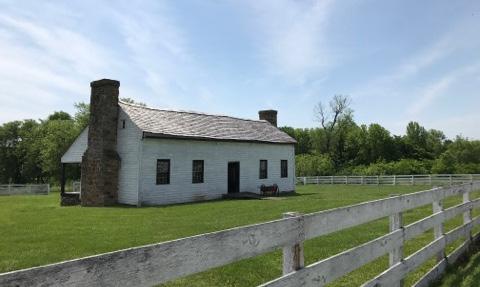
“This work helps us to have a better understanding of how life unfolded here in the 19th century; it gives us a starting point to better tell the stories of the lives of the individuals enslaved on the homestead,” Busekrus said. “As history continues to reveal itself, we will continue to tell the story.”
(Left) In the cemetery, Nathan and Olive Boone’s graves are among the few of the known locations. (Photo: Courtesy of Missouri State Parks) (Right) Nathan and Olive Boone’s homestead located near Ash Grove, Missouri. (Photo: Courtesy of Missouri State Parks)






Smallmouth bass are considered the hardestfighting fish in the Ozarks. The Algonquin Indians called the smallmouth bass “Michigan,” which means “the one that fights.” Few will argue the fact that the smallmouth bass stands head and tail above any other fish species that swims our Ozark rivers.
Fall is my favorite time to fly fish for smallmouth bass. The weather has cooled, brilliant colors blanket the hardwood ridges, and the aluminum hatch of canoe hordes are gone. Fall is the season to fish the three classes of flies for smallmouth to cover the entire water column.

Topwater flies are classic smallmouth baits. Anyone who loves smallmouth bass does so because of their no holds barred attitude of smashing topwater baits. The very action paints a vivid picture of the moment a smallmouth strikes on the gray matter of addicted anglers. It’s that explosive action that keeps us coming back for more.
Bass bugs are intriguing. They look fishy and conjure up mental images which ardent anglers dream about. And the truth of the matter is that surface flies will many times elicit far more strikes than subsurface flies and bottom bouncers. They are by far the most fun to fish flies of the three categories.
Poppers with rubber legs are perhaps the most popular and readily available of the surface baits for smallmouth. Most major fly fishing gear retailer will have plenty of these marvelous baits in stock. My favorite fall colors include black, white and yellow, with a variety of patterns and eyes.
Deer hair poppers are eye-catchers for both fly anglers and smallmouth bass. Usually, these flies have a bulky build, which means one thing to a hungry smallmouth, a big meal. They can be a bit difficult to cast, because they catch a lot of air. I often upsize from my standard 6-weight river fly rod to a number 7. It makes life much easier and I can fish longer without tiring.
Mouse patterns are another favorite, not so much because they are any better than poppers, but the intrigue of a big smallmouth sucking a small mammal from the surface is mind candy to a fly fisherman.
Big hopper patterns are another deadly pattern to use in the fall season. Grasshoppers are abundant in the fall, and many of these big terrestrials wind up in the drink, where smallmouth bass relish the big, juicy bugs and inhale them with vigor.
All of the topwater offerings shine in slower water. The glassy water behind an eddy, the calm behind a fallen log, and the slack water behind a big rock are all classic topwater spots. Most often these spots offer one shot. After the big bug plops down, allow it to sit for a long few seconds. Smallmouth are accustomed to things falling into the water. Most often they investigate for a few seconds. A slight twitch of the popper is normally all it takes for a smallmouth to be fooled into striking.
As fun as they are to fish, topwater baits don’t always turn the trick. Divers are deadly. They produce erratic, fast retrieve, and pull strikes much like a crank bait. Divers are difficult to pick up. It’s best to retrieve them all the way back and pick them up on a short line.
The Clouser minnow is one of the few baits made specifically for smallmouth bass. The dumbbell eyes are the key to the Clouser. The hook rides up during the retrieve, and helps keep it from snagging while hooking fish in the roof of the mouth. Clousers come in a wide variety of sizes, making them a good choice for a wide variety of applications.
Wooly Buggers are perhaps the most popular subsurface flies for smallmouth bass. They imitate crayfish and minnows, depending on the colors used. They come in a wide range of sizes, but bigger is better for smallmouth.
I like to fish Wooly buggers on leaders at least 12-feet in length. I also prefer a heavy leader in the 10-pound class. You will be tossing these baits into the current with rocks, logs and other debris. I’ve caught smallies to 6-pounds on Wooly Buggers, but it’s a very sick feeling to have a real bruiser break a light leader.
My all-time favorite smallmouth fly was patented by my late, great friend Ron Kruger. The Dipsey Diver is made of a cork head with a concave, rat-looking face and a big hook. Ron often included a clump of deer hair behind the head, with a variety of wraps and feathers behind. He cast the mousy looking fly into a slow current and stripped it back. The faster the strip, the deeper the Diver would go. The kicker that smallmouth cannot resist, however, is the wide, slow wobble of the fly.
Fly choices for bottom-hugging smallmouth involve one of the most fascinating sagas of the fly fishing world, imitating crayfish. Smallmouth bass relish crayfish and fly tiers have created an unimaginable variety of imitations.
When it comes to crayfish patterns, smallmouth are so attuned to gorging themselves on the crustaceans, that the power of suggestion works well. Super realistic plastic crawfish patterns are heavily utilized by spin fishermen, but fly anglers craft imitators from available materials and do quite well. I tie a pattern utilizing a fox squirrel's red and black fur.
Weighted Wooly Buggers and articulated flies are other popular choices for fall smallmouth. Olive, brown, black and yellow are great fall colors. Strip these patterns with an erratic retrieve and hang on for the ride.
Floating an Ozark stream in the peak of the fall colors and casting your favorite smallmouth flies in hopes of fooling an ancient smallmouth bass is a heady experience. Like me, I’m certain that smallmouth bronze will quickly become your favorite fall color.
Bill CooperWooly Buggers are one of the most popular flies every made. Smallmouth bass take them readily. (Photo: Bill Cooper)

Iused to see Pete at church almost every Sunday. He would be on a bench in the main hallway, telling stories to anyone who would listen. He knew that I wrote articles for magazines and newspapers about the outdoors. When he saw me, he always wanted me to come over so he could tell me his fish stories.

He would start with, “It is midnight on a hot summer day. The moon is full, bats are diving in the night sky, and fog shrouds the lake. I am out fishing by myself in an old wooden boat. The night fills with sounds. Crickets chirping, owls hooting and frogs croaking. I take my old fishing rod and throw a topwater bait toward some bushes next to a log. I let it settle and start reeling. It gurgles and wiggles back toward me.
Suddenly, a bass, a monster bass, attacks my bait. It rises from the water with the plug hanging in its jaw.”
Pete always acted out his fight with the bass. I loved the expressions on his face while he told it. Pete would lean back on the bench reeling it in on his imaginary fishing rod.
He would always have a grimace across his face as he turned the reel handle. His eyes would get big as he described the fishing line being pulled from his reel by the fish.
Sometimes Pete would add to the story with moans about backlashes in his braided line. He would frown and tell me it required valuable time to untangle. Then he would smile and proudly tell me that he still got that fish into the boat. Then he would say, “I unhooked that bass and put it back in the water to watch it swim away.”
Sometimes, he would tell me another story. It was about another big bass. That he caught and released but not on purpose. “It almost took the rod right out of my hand,” he would say. “When it was close to the boat, it shook loose from the hooks. I watched it disappear into the darkness of the water.” Of course, like most fishermen, the bass also got bigger each time I heard his story. Sometimes the bass was so big it was pulling his small wooden boat around. I listened each time as I had never heard Pete’s fish stories.
Pete is a 98-year-old World War II veteran. One of The Greatest Generation. He was a U.S. Army paratrooper. In the European Theater Campaign, he served under General George Patton. He fought in the Battle of the Bulge and the Battle of Bastogne. He was also part of the Rhine River Jump. It is hard to imagine what Pete and all those other men went through fighting for our country.
His daughter Cora told me she flew with her Dad on one of the first Honor Flights for veterans. Honor Flights are all-expenses-paid trips to the war memorials in Washington, D.C. These flights give veterans the time to share this momentous trip with other veterans, remember friends and comrades lost, and share their stories and experiences. As the plane prepared to land, Cora asked her Dad what it was like back during the war when he was getting ready to land and go into battle. Pete looked at her and said, “I don’t know. I always got on a plane, but I never landed on one. I was always jumping out of them.”
On Veteran’s Day at church, Pete would bring in a big glass-covered shadow box with all his medals from World War II for all of us to see. There are many. He always stood with pride as all veterans would stand so we could honor them. I often saw tears in his eyes as Pete faced the flag with everyone, put his hand over his heart, and we all sang God Bless America.
Up until this year, Pete lived by himself and cooked his meals. He drove himself to go grocery shopping, other errands, and church every Sunday. Pete even loved to go out dancing. He had more energy than most men half his age. Then cancer reared its ugly head. Pete is tough. He is fighting this battle too. He knows where he is going when his time comes. I am sure there will be a lot of family and military buddies that will be glad to see him again. I bet they will get to hear Pete’s fish stories too.
I visited Pete along with another man from our church at the home Pete built many years ago. His daughter Cora seated us in the living room and went to tell Pete we were there. Pictures of his wife, four children, ten grandchildren, twenty-five great-grandchildren, and two great-great-grandchildren were on every wall. So were pictures of a younger Pete in his army uniform. The shadow box with all his medals was there too.
I was expecting to see him in bed. Instead, Pete slowly walked into the room with support from his cane and sat in his favorite chair. He was glad to see us, but I could tell he was tired and in pain. We didn’t hear any fish stories that day, but we did hear several war stories.
We lose more of these men and women who sacrificed so much for us every year. Less than 200,00 of the 16 million men and women who fought in World War II are still alive. There won’t be any of them left in a few more years. Only twenty percent of the 6.8 million men and women who fought in Korea are still alive today. Veterans like me from the Vietnam era are in their 70s now. Veterans lucky enough to make it home from the Gulf War, Iraq, and Afghanistan came home with scars. Not just on their bodies but in their minds.
Our kids and grandkids need to hear the stories about these men and women. When we hear our national anthem, those that kneel need to listen to their stories. Those who protest and disrespect our flag need to listen to their stories. Our politicians need to listen to their stories. Then they need to do everything possible for these men and women.
We all need to take the time to thank our military men and women who served our country or are serving now. Not just on Veteran’s Day each year. We need to do it every time we have the opportunity. If you see a veteran wearing their branch of a military service cap, thank them in some way. That’s the least we can do for all they did and are doing for each of us.
Every Sunday, when I come in the front door of our church, I still look over at the bench where Pete sat. I see him in my mind’s eye telling me fish stories. As I stand before everyone to give the weekly church announcements, I look to where Pete was always sitting a few rows to my left from the front. I wish he could still be there proudly wearing his World War II Veteran cap. I miss hearing Pete’s stories.
Larry Whiteley(Left) Pete Dye: a proud American. (Photo: Sac River Cowboy Church) (Right) Pete's shadow box of memories. (Photo: Cora Parrish)
We all need to take the time to thank our military men and women who served our country or are serving now. Not just on Veteran’s Day each year. We need to do it every time we have the opportunity.
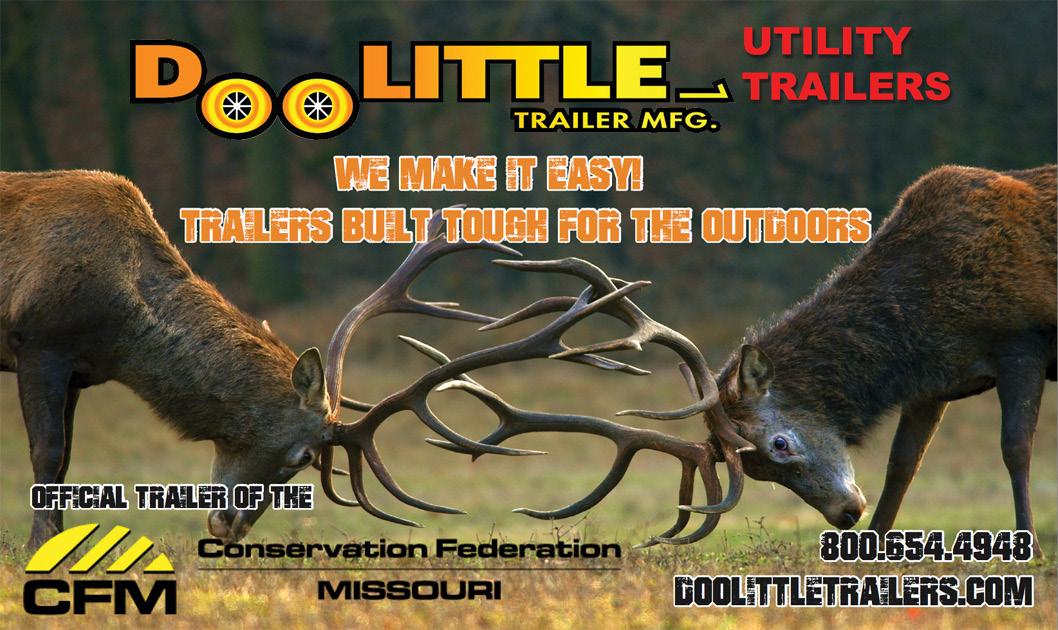



Let me begin by stating that I am not an angler. I do enjoy fishing, but I know nothing about which jig to use, what size line, types of rods and reels, etc. My late husband, Wil, would always bait the hook and hand me the rod, much as many fishing guides do. When I catch something, I am happy. When I don’t, I just enjoy the outing.
So when I tell you about my successful summertime fishing trip to Norfork Lake and Gaston’s White River Resort, just across the state line in Arkansas, please believe me that it was pure luck or skillful guides, because I really do not know what I am doing other than having fun in a boat on a lake or river.
You can do the same. Planning an outing for next spring or summer is a pleasant way to pass a chilly winter day. For that matter, you can fish in the winter, too!
The story begins with a two-day outing to catch stripers in Norfork Lake, near Mountain Home, Ark. I’d heard about how much fun it was to fish for stripers, that they put up a super fight. At last, I had a chance to give it a try. I dreaded the heat because the forecast was in the 100-degree range for while we were there, but we beat the heat by getting on the water early (well before sunrise) and quitting by midday when the heat was becoming oppressive.

Our home base on Norfork Lake was the delightful, oldfashioned, Ozark rock cabin getaway, Three Oaks Resort. Owner Don Lawellin cheerfully met us before dawn to show us how to use the funicular to ride from the top of the steep bluff down to the dock on the lake. I’ve seen these small, personal railways at the Lake of the Ozarks and other places, but have never had a chance to ride one. Now I have. And when we stopped fishing for the day and returned to the dock, it was a relief to be able to ride up instead of having to walk up the steep and rocky incline in the heat.
My companions for this fishing adventure were Kenneth (Kenny) Kieser, an outdoor writer and frequent CFM contributor from the Kansas City area, and Jill Rohrbach, a travel and outdoor writer for Arkansas Tourism. The two of them are experienced anglers, but they were tolerant of my amateur abilities. Kenny, Jill and I were greeted by veteran fishing guide Jake Dale, of Reel Fish Guide Service, and off we went in the cool morning air. Dale had rigged up the most unusual fishing apparatus I had ever seen – an umbrella sort of gizmo with various colors of 3/4-ounce jigs dangling from it. To me, it resembled a mobile to hang over a child’s crib. Unusual though it looked, it worked great for trolling for stripers.
As the boat motored along about three miles per hour, our rods dipped slightly from the pull of the water on the umbrella rigs. Then my rod took a sharp dive and I grabbed it, pulling it out of the holder and positioning it against my abdomen as I struggled to reel in what felt like a whale on the end of the line! My gosh, what a fight! Or maybe I’m just a weakling. But in the end, Dale netted the striper when I got it alongside the boat. It measured 29.5 inches. Holy moly! I didn’t realize until I read Kenny’s article about the trip that my striper was the biggest one caught that day. Beginner’s luck, I have to say. Or as Jake put it, “Sometimes the best bait is perseverance. You put that bait in front of them, and eventually you’ll catch one.”
I was hooked on striper fishing, for sure. As if that whopper weren’t enough, the next treat was a beautiful sunrise over a bridge crossing the lake. What a way to begin the day. I managed to haul in several more stripers, as well as a few hybrids (a cross between a striper and a white bass), including one that measured 23 inches, that day and the next, before we decamped at Three Oaks, and headed to the White River for some trout fishing.
I’d heard about Gaston’s White River Resort for decades, and went there once for a meal, but I’d never had the pleasure to stay or fish there. Jill and I shared a lovely two-bedroom cottage, and we ate all our meals in the restaurant at Gaston’s because the food was so good that there was no desire to load into the car and look elsewhere.
As nice as the cottage and restaurant were, the best was yet to come. Kenny had been talking about catching a big brown trout all the way over to Gaston’s. He was a man on a mission and was paired with veteran guide Lynn Hicks for a day of serious fishing.
Jill and I went with Shawn White, of Whitey’s Custom Cranks and Fishing, who has been guiding for Gaston’s for years. Jill started reeling them in right away, but I wasn’t even getting a nibble. I was fine, enjoying the scenery and taking photos of the river below Bull Shoals Dam. But I could tell Shawn was getting worried that I wasn’t catching anything. I’ve fished for trout on Lake Taneycomo and at several state parks in Missouri many times, catching both rainbows and browns, so I wasn’t stressed about a first-time fish. Then suddenly they started biting, and I reeled in a 21-inch brown trout to start off what would be one of the most amazing days of fishing in my life. After hauling in several respectable rainbows and several more good-sized browns, I was quite happy with the day’s catch. Then the magic happened.

As I was reeling in yet another fish, I gasped when I saw what was on the end of my line – a golden trout, shimmering in the sunlight as it rose up from the deep green waters toward the surface. Jill and Shawn were excited, too, and he urged me to be cautious and gentle with this special fish as it neared the net. He carefully scooped it up and Jill took the quickest photo possible so Shawn could gently lower it back into the river and steady it until it was ready to swim off. We watched as it disappeared into the depths, amazed by what we had just seen. I looked at Jill and blurted out, “I hope my husband was watching this from up in heaven.”
Although we continued fishing, I was in a state of complete awe. A rainbow, a brown and a golden trout all in one day. My trout trifecta. And it’s not a fish tale – I have witnesses and photos to prove it! All this on a 110-degree heat-index day when any sane angler would have stayed off the water. Kudos go to Shawn who knew how to help us fish for trout on the White River on a hot summer day.
Meanwhile, Jill and Kenny had a great day of fishing, too, with Kenny hauling in a 22-inch brown, the day’s largest. I lost track of how many trout Jill reeled in. I’m pretty sure she took first place for the most fish caught that day. We each had our own fish tale to savor and share.
After quick showers to wash off the sweat and fish slime, we gathered in the restaurant at Gaston’s. We laughed as we watched the antics of a raccoon busily raiding a squirrel feeder outside the dining room window, while squirrels scurried below, grabbing what the raccoon dropped. Hummingbirds whirred by as they flitted from feeder to feeder. And then the icing on the cake: a rainbow appeared right in front of us, hovering over the White River. Can it get any better than that?
If you’re looking for a holiday gift for the angler in your life, you might consider planning a trip to Norfork Lake for stripers combined with a stay at Gaston’s on the White River for trout. But watch out -- Santa might be tempted to hang on to that gift for himself!
For more information, visit these websites: Gaston’s White River Resort, gastons.com Three Oaks Resort, 3oaksresort.com Norfork Lake, norforklakefun.com Shawn White, whiteyscustomcranksandfishing.com Jake Dale, reelfishguideservice.com Arkansas Tourism, arkansas.com
Barb Ostmann(Cover) Sunrise on Norfork Lake with a striper rig trolling in the water. (Photo: Barb Ostmann) (Right) The catch of a lifetime — a golden trout! (Photo: Jill Rohrbach) (Top) Jill Rohrbach snaps a photo of Kenny Kieser and a s triper on Norfork Lake. (Photo: Barb Ostmann)

Where have you been? I’ve been waiting for you. Especially this year. It’s been unbearable without you.
Things are changing and I worry. Your arrivals have been a little later, departures too soon.
I know you have a lot to do and you’re falling behind but will I see you again?
When you are here things are so much better. Everything changes. I wait for you.
In September I get anxious. In October I get ready.
In November and December I count on you.
I celebrate your arrival and I ask you without demand, do what you do, please.
Change the color of leaves and make them fall to the ground begging for mercy.
Put away the incessant sunshine of summer. Gray skies. I want your gray skies.
Give me a chill, a big chill. Slap me with a polar vortex and make me shiver.
Make cheeks red, noses run, toes a little numb.
Remind me of what keeps us alive, and tease me with threats.
I dare you, cut me. Pierce me with sharp winds. Remind me of the reasons I own sweaters of wool, buckskin mittens lined with fleece, and pack boots.
Push the masses indoors. Let them hibernate.
Show them frost. Crystalline frost. Dust the woods white. Show me snow.
Fill my senses with winter sounds, silence, and wood smoke.
Fill my woods with robins, flickers, and waxwings. Let them rest and feed.
Bring the juncos to the yard. Let them stay as long as they want, as long as they need.
And as the pileated laughs crazy, turn the dirt to concrete, and when the ducks are fat and ready, turn the water into rock.
Leave the fields, woods, and marshes to the flock of St. Hubertus.

Give them the altar they need. Let them pray.
Let them hear the grunt of rutting bucks, and see scrapes and rubs.
Let them see tracks in the snow; feathers, fur, specks of red.
Allow them to know the sentiments of geese as they give voice to the stars at night.
Make them nostalgic remembering when. Remembering why.
Make them find the old books to read again and again. Inspire them. Make them think. Make them cry.
In January you’ll get bored. So much work to do, territory to cover.
I can see it’s getting harder. Rogues at work limiting your reach.
Some still feel your wrath, but not so many anymore. Slowly, the rogues are winning.
Dan Zekor

Locally and globally, invasive species are the second leading cause of native biodiversity decline and also threaten the economic stability of the forest product, livestock, and outdoor industries. In terms of invasive plants, Missouri has an excellent resource to help landowners and outdoor enthusiasts tackle them: the Missouri Invasive Plant (MoIP) Council, which advocates for making early detection and control of known and potential invasive plants a statewide priority.
In 2015, the Missouri Prairie Foundation’s Grow Native! program spearheaded MoIP—multi-agency, multi-industry networking and advocacy group to bolster statewide efforts to identify and control the invasive plant species that severely impact several sectors of the Missouri economy and native biodiversity.
The purpose of MoIP—working as a united, supportive front—is to review, discuss, and recommend educational and regulatory action related to managing known and potential non-native invasive plants. Representatives from the fields of conservation, agriculture, botanical science, ecological services, plant production, horticulture, landscape services and design, and arboriculture serve on the MoIP Council.
At MoIP’s website, moinvasives.org, there is a searchable database with photos of many common invasive plants, together with treatment information. For example, nonnative bush honeysuckle is easy to spot in the fall as its leaves remain on the branches after leaves of native deciduous trees and shrubs have fallen.
Identifying and treating this highly invasive shrub that chokes out native vegetation in woodlands and forests are critically important to the future of native biodiversity and outdoor recreation including hunting, as well as to the regeneration of oaks and the forest products industry. At moinvasives.org, you can also find downloadable posters of top expanding invasives statewide and by region. MoIP invites landowners, municipalities, neighborhoods, campuses, businesses, and other entities that have plans in place to control invasive plants to take the “Stop the Spread” of invasives pledge. To date, 170 landowners and others have taken the pledge.
MoIP Invasive Plant Action Awardee for 2022: Steve Cavin

In 2019, MoIP established its Invasive Plant Action Award program to recognize individual citizens, organizations, researchers, and collaborative efforts. The 2022 awardee is Steve Cavin, Senior Ecological Restoration Specialist with Native Landscape Solutions, Inc., based in St. Louis, Missouri. He is known among his peers as a knowledgeable, passionate, and kind-hearted educator in the world of invasive plant control. Steve has worked tirelessly to become a master at plant identification and invasive plant control solutions. He has successfully worked on many invasive plant control projects in the St. Louis area for Powder Valley Conservation Nature Center, Forest Park Forever, Metropolitan Saint Louis Sewer District, and the U.S. Forest Service. These projects ranged from work at the Saint Louis Riverfront Butterfly Byway and Great Rivers Greenway, to several municipalities including Kirkwood, Wildwood, Brentwood, Des Peres, Saint Peters, Saint Louis, and Sunset Hills. Congratulations, Steve!
For comprehensive invasive plant information, including the resources mentioned above, visit moinvasives.org
(Left) In fall, the yellow leaves of bush honeysuckle are easy to spot. Fall is an ideal time to treat this invasive plant. (Photo: Scott Woodbury) (Right) The red berries of non-native, invasive bush honeysuckle are eaten and spread by birds.(Photo: Scott Woodbury)
For those confused by the various categories of plants, MoIP provides these definitions:
Native
Native plants originally occur within a region as the result of natural processes and are adapted to local climate and soils. They have co-evolved with native insects and wildlife and are critical to ecosystem functions. For MoIP’s purposes, native plants are those species present prior to widespread European settlement.
Non-native plants are those introduced (intentionally or accidentally) to a new place or new type of habitat. Historically, most of these introductions have resulted from human activities. Since they did not evolve locally over thousands of years, their presence can often have negative impacts on endemic ecosystems. The words “exotic,” “alien,” and “introduced” are synonyms for “non-native.” Note: not all non-native plants are invasive and these generally are not the focus of MoIP’s attention.
Aggressive plants are species that, usually because of human-caused disturbances, spread rapidly and can outcompete other plant species. Aggressive plants can be native or non-native, and they may be aggressive in some situations, but not in others.
An invasive plant species is an aggressive, non-native species whose presence causes or is likely to cause economic harm or environmental harm. These species grow and reproduce rapidly. (Modified from Invasive.org.)
MoIP is most concerned with invasive species because of their direct negative impacts.
















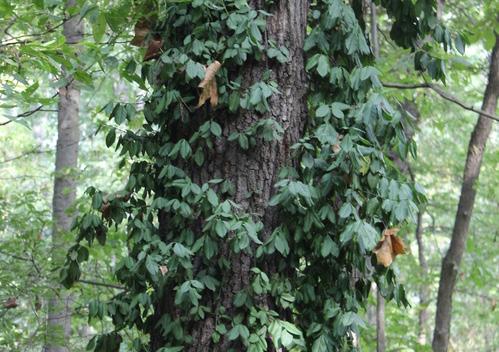




































N
D M O
Justin Lee grew up in a North Missouri family of deer hunters and had killed several nice bucks over the years. Some were taken with firearms and several more using a crossbow, but he had never killed a buck with a compound bow.

On the morning of November 12, 2020, Justin hunkered down by a large bur oak tree, clacked two old deer antlers together, and waited.
As he knelt at the base of the old oak on this frosty November morning, bow in hand, a two-year-old, eightpoint buck silently materialized from the gray woods 30 yards in front of him. A cold breeze drifted through the brittle leaves, carrying the hunter’s scent away from the keen nose of the deer. The deer's white antlers contrasted sharply to the autumn woods as he walked in a line, moving steadily closer to Justin's tree.
With the skill of a veteran hunter, Justin had twisted his body slightly at first sight of the deer, positioning himself to draw, well in advance of the deer's approach. The deer kept coming, intent on the woods around him, searching for the deer he thought he heard sparring just a few seconds before. The angle wasn't perfect, but the deer was very close. Sunlight glinted off the moist black nose of the buck. The moment of truth was at hand. With minimal movement, Justin bit down on the two-inch piece of dog collar attached to his bowstring, felt the stitches in the corner of his mouth for his anchor point, and pushed the bow straight out in front of him with his right arm, coming to full draw. The buck stopped momentarily. Justin settled the pin in his peep sight on the deer's chest.
Justin Lee was born with brachial plexus injury to his left arm. The brachial plexus is the network of nerves that sends signals from the spinal cord to the shoulder, arm, and hand. A brachial plexus injury occurs when these nerves are stretched, compressed, or in the most severe cases, ripped apart or torn away from the spinal cord. These nerves control the motions of your wrists, hands and arms, allowing you to raise your arm, type on your keyboard, or throw a baseball.
Or hold and draw a bow.
Growing up with this injury, drawing a bow just wasn’t an option. Having the hunter's instinct to head to the deer woods each fall, Justin adapted. The woods didn't care what challenges he or any other hunter faced. The challenges remain the same for the modern hunter just as they were for hunters from different centuries. There are no shortcuts.
Justin learned to shoot a rifle and then, to make things more challenging for himself and to extend his hunting season, a crossbow. Justin found himself headed back to the timber each fall, answering the irresistible call of the November woods. Justin had known success. Growing up in a time of deer abundance in north Missouri, he had become an accomplished deer hunter.
Always looking for a challenge, Justin had tried to figure out a way to hunt with a compound bow. But how could he draw, aim and shoot a bow without using his left arm? The answer came to him one day on Facebook, when he saw a post by Chris Ruggles of Excelsior Springs. Chris also dealt with brachial plexus injury after a car accident.
Another determined deer hunter, Chris, had learned to draw his bow by biting on a piece of nylon dog collar attached to his bowstring and pushing the bow out in front of him. Ruggles had taken a deer or two with this one-handed draw method. Justin contacted Chris, and the two met in Excelsior Springs. It didn't take long for a friendship to develop.
Impressed by what he learned and by Chris, Justin went directly to a bow shop and purchased a PSE Uprising youth bow. He set the bow up, attaching a two-inch piece of nylon dog collar to the bowstring like Chris had done, and began the process of learning to shoot by drawing the bow one-handed. Justin remembers that the biggest problem he faced was not drawing the bow. Justin is right-handed and right-eye dominant. He had to not only draw the bow while holding the piece of collar in his teeth, and he had to train himself to use the bow's sight with his left eye. By closing his right eye, he eventually forced his left eye to look through the bow sight and pick up the target. He slowly began to group his arrows and gain confidence. By the fall of 2020, he was ready. He would hunt with a compound bow.
The deer at the beginning of our story stopped just 10 yards from where Justin knelt with his bow drawn. He released his jaw-toothed grip on the bowstring and the arrow found its mark. The buck staggered backward, turned to run, then fell heavily and expired. He was felled by the arrow of a bow hunter. A guy who was determined to hunt deer with a bow, no matter what.
Justin continues to hunt deer with a compound bow. He has upgraded to a PSE Brute and can shoot a very tight group at 25 yards and beyond. He will be out there somewhere when the leaves turn and the mornings get crisp doing what he likes to do—Hunt white-tailed deer with a bow and arrow.
I wouldn't bet against him.
Kyle CarrollJustin Lee practicing with field points as he prepares for hunting season. (Photo: Kyle Carroll)


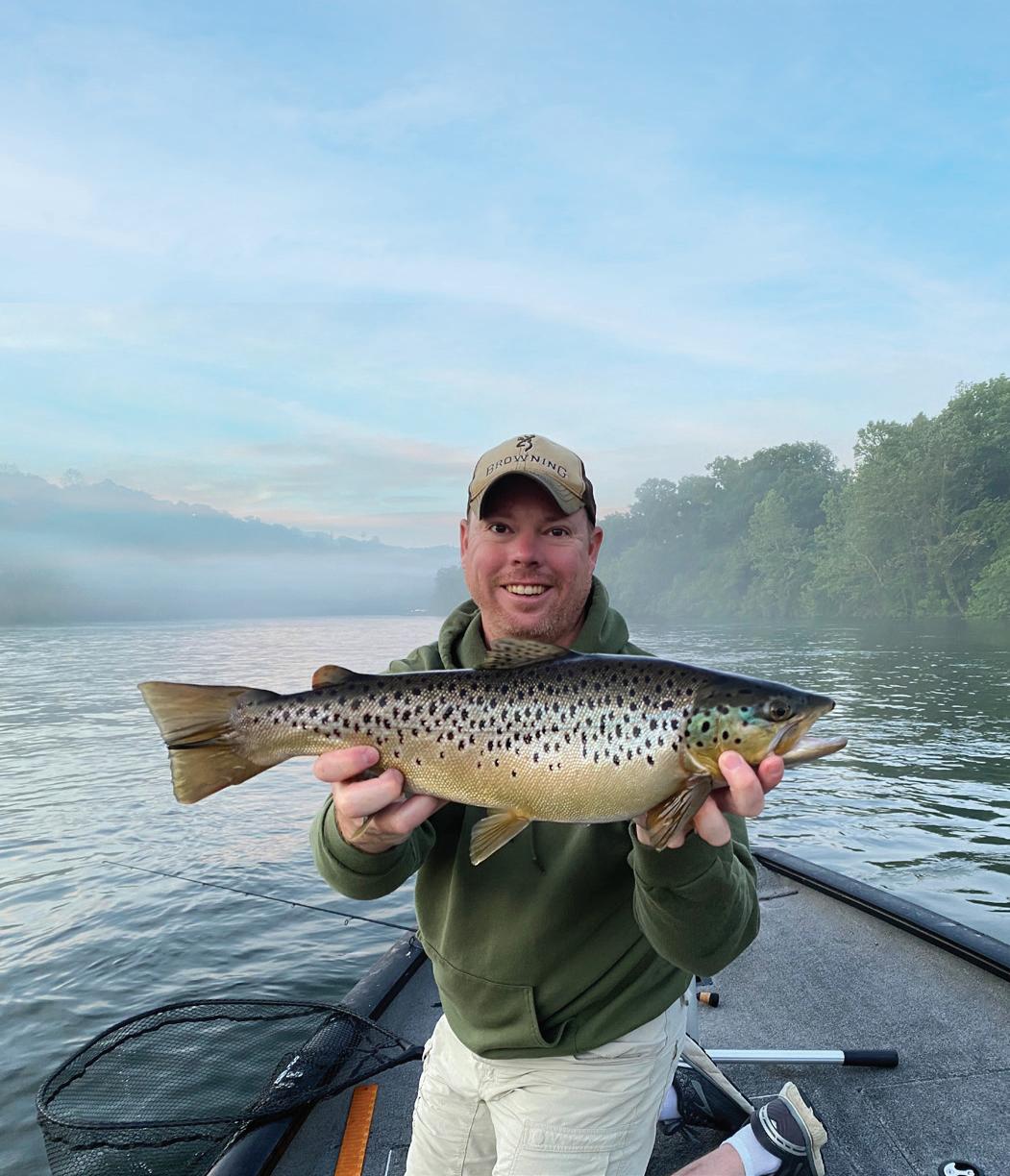









Like a faithless lover, duck hunting is hard to give up on. I, along with many other Missouri waterfowlers, had written off the 2016-2017 duck season as a bad job weeks ago. But when hunting buddy and long-time friend Bill Powell asked me to join him on one last hunt at Pomme de Terre Lake, the siren’s song was irresistible. Here was a chance to redeem an otherwise disappointing season with a mixed bag of divers and puddle ducks. Who knew, maybe a brace of canvasbacks awaited us.
A large part of Bill’s motivation lay in testing the blind he was building for his new duck boat. I might have seen the handwriting on the wall when, the night before our departure, he admitted that work on the blind had not progressed as hoped. So, instead of hunting from the comfort of his boat, we would motor to our chosen spot and hunker down in brush at the water’s edge.

My misgivings vanished when I woke to dress at 2 a.m. and peered out the bedroom window. The fog was thick enough to stir with a spoon. Duck weather! By the time we got to Wheatland Park on Pomme de Terre’s northwestern shore, the air was so thick I had to groundguide Bill as he backed the trailer down the boat ramp. Launching the boat turned out to be the least of our problems. The new, 25-hp Mercury motor stubbornly refused to catch, despite repeated mental reviews of the starting checklist. Tank full? Check. Fuel Line connected? Check. Vent open? Check. Primer bulb pumped and firm? Check. But still no ignition. Ten minutes and several expletives later, Bill discovered the missing item on his list. Kill switch? On! Switch to off position…Varoom!
With motor purring like a contented tiger, Bill turned the bow into…an impenetrable fog bank. The boat ramp was still visible, so Bill knew which direction was north. All we had to do was motor three-quarters of a mile due south. But even in our sleep-deprived condition, we were sharp enough to know we would lose our bearings the moment the shoreline disappeared, and Bill’s boat had no compass or GPS unit to guide us. With the boundless and equally unjustified confidence inspired by technology, I whipped out my smart phone and launched Google Maps. In seconds, I was looking at a dot (us) moving slowly across the screen headed – due north?
“Turn around!” I shouted over the motor’s roar, fearing we might crash into the shore we had just left. Bill dutifully turned what he judged to be 180 degrees and soon had us headed – due east. “Turn right!” I shouted over the motor’s roar.
This went on for five or 10 minutes until the boat ramp appeared again. That’s when it dawned on me that the cursor on my phone’s screen had changed from the usual arrow, with its pointy end indicating direction of travel, to a largish dot with a funnel-shaped thing protruding from one side. This led to several questions. Why had the cursor changed? Had I accidentally switched a setting? Did Google Maps automatically change when we went from land to water? From day to night? Was that funnel supposed to be the wake behind our boat or a beam of light preceding it?
This, in turn, led to several minutes of fumbling with settings, widening and narrowing the view to find landmarks and ordering Bill to go faster, slower, stop, turn left, turn right and stop altogether while I tried to figure out how facts on the water related to the image on my screen. About this time, Bill looked up and exclaimed, “Oh, there it is!” Apparently I had navigated us – entirely by accident – to the desired spot. Never ones to look a gift horse in the mouth, we proceeded to transfer our hunting gear to shore so Bill could motor farther down the cove (keeping the shoreline in sight!) and hide the boat. Meanwhile, I began setting out decoys.
Everything went smoothly until I dumped the bag containing scaup decoys on a 100-foot jerk line. There was evidence of an elegant scheme to keep decoy cords and the main line orderly. However, that effort had been defeated by the hurlyburly of tossing decoy bags into and out of truck and boat.
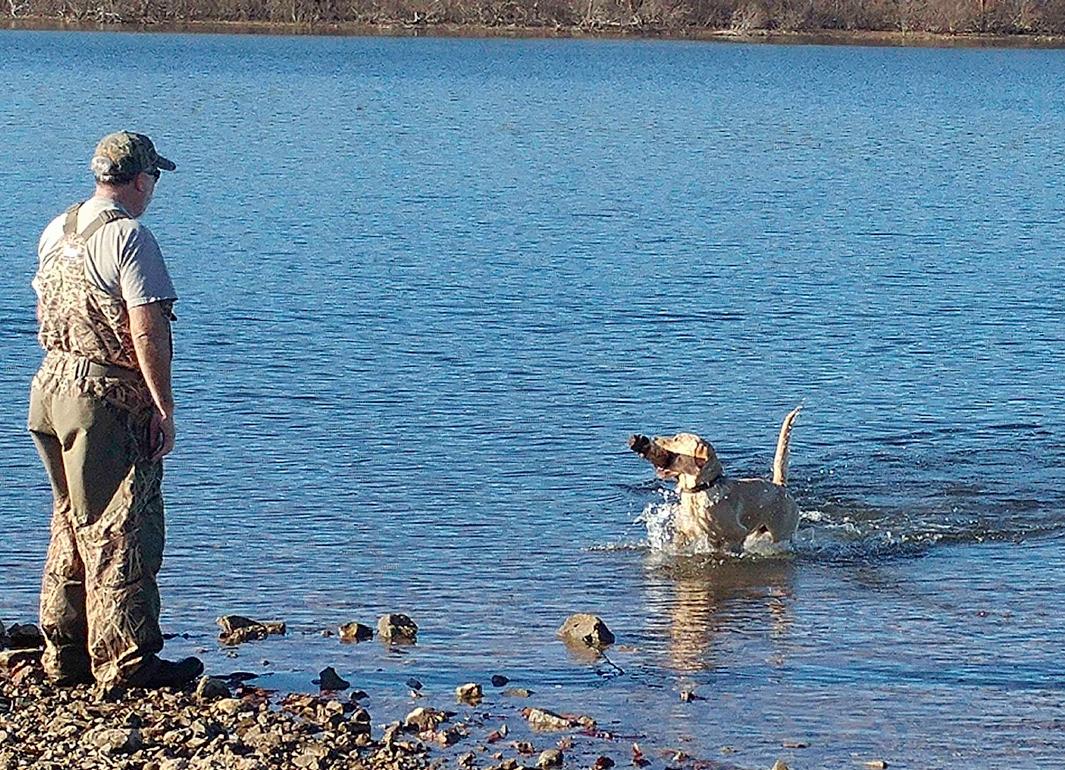
Utter chaos now prevailed, and a pocket knife seemed the only remedy. Bill set about deploying the other decoys while I applied years of experience with tangled baitcasting reels to the diver rig. Amazingly, I had it mostly untangled by the time shooting light arrived.
That’s when Bill discovered that he had left our stools and food in the truck. No matter. We had managed to remember our guns and ammo, and we had camo netting to drape over buttonbush and willows to create individual blinds. We were set. All we needed was ducks.(Cover) The fog might not have contributed to hunting success, but it did create some memorable visuals. (Photo: Jim Low) (Right) Bill’s dog Hector had a great time retrieving sticks while we worked with decoys, and he slept like the dead during the drive home. (Photo: Jim Low)
Late-season hunts on southern Missouri’s big Corps of Engineers reservoirs are most productive when neighboring ponds and streams are frozen. That had been true the previous week. However, the past few days had been warm, and puddle ducks now were contentedly preening on a thousand farm ponds. So, we pinned our hopes on diving ducks, whose preference for big water keeps hunters in business at Pomme de Terre regardless of the weather.
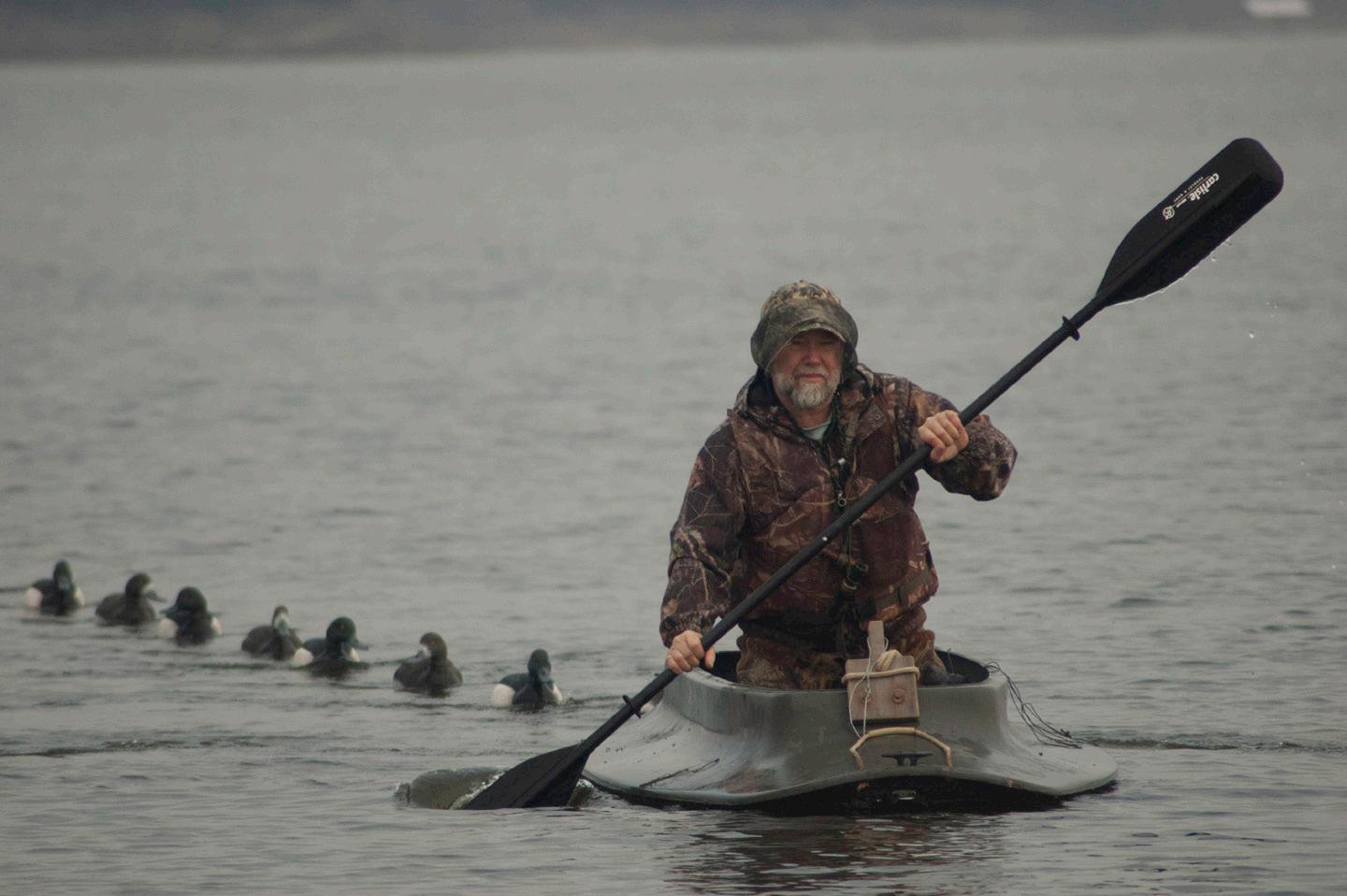
We saw a few goldeneyes and ringnecks, but none showed significant interest in our decoys. The only shots we fired were at a pair of Canada geese that strayed dangerously close around 8 a.m. Feathers drifted down as the pair disappeared into the fog. Moments later, we heard honking out on the water a few hundred yards away. The distressed calling continued, and it seemed clear that one of the birds was down. Bill hot-footed it back to the boat with his retriever, Hector, and went in search of the crippled bird. They returned emptyhanded half an hour later.
Two hours and several decoy adjustments later, we admitted defeat and collected our gear. As we motored back to the boat ramp, Bill noticed that his shotgun was missing. Back to the point we went and retrieved the gun in its cunningly camouflaged case. At least the fog had lifted, and we could find the way without digital assistance.
We experienced what we thought was our final humiliation of the day at the ramp.
Earlier in the morning, when Bill pulled up to park his truck after launching the boat, the fog apparently had confused him so thoroughly that he parked 50 yards too far downhill. As a result, his trailer was blocking half of the boat ramp’s width. “Did I really do that?” Bill asked in dismay. Yep. He sure did.
The one boater who arrived after us had kindly refrained from leaving a nasty note or scratches on Bill’s new truck.
But he surely must have had some choice words for the rubes who preceded him.
On our way home, as Hector snoozed contentedly between us, we decided to visit a pond owned by one of my neighbors. Geese regularly visit there, spreading gooey green poop liberally across the lawn and sidewalk. She is delighted to have me visit periodically and put the fear of God in these feathered manure spreaders. To simplify our approach, we traded vehicles, putting guns and a retriever in my truck for the trip to the pond.
Alas, we found it deserted, dashing our last hope. I dropped Bill and Hector back at his truck before heading home, ready for a nap. Then I realized that Bill hadn’t retrieved his shotgun from the back of my truck. After a quick phone call, we both reversed directions and returned to our rendezvous point to do a final sorting of gear. He still ended up with my phone charger, but that was small potatoes in the Chinese fire drill that our day had become.
Every hunt creates memories, regardless of whether game is taken. If nothing else, our last duck hunt of the season resulted in a full limit of stories to tell.
LowNothing lasts forever. This common phrase is uttered regularly upon the loss of opportunities and objects both big and small. The notion, though, that hunting could one day be completely a thing of the past is hard to fathom for those of us whose passion is lifelong. We’re aware of declines in participation and increasing opposition, but are we forward thinking enough to recognize the potential of finality? Thankfully, some hunters are.
The First Hunt Foundation (FHF) works to mentor and coach young hunters with the hope of ensuring a safer future for our hunting heritage. Rick Brazell is the President and Founder of the FHF, which has over 800 volunteers spread throughout 38 states. His hope is to have thousands of mentors in the future. To accomplish this, it’s going to take partnerships and money. Both of which are materializing.
The National Rifle Association (NRA) Hunters’ Leadership Forum has engaged with the FHF. Together, they have established a “Hunting Heritage” endowment.
“The NRA Hunters’ Leadership Forum is happy to support the First Hunt Foundation,” said Peter Churchbourne, Director of the NRA Hunter’s Leadership Forum, in a recent press release. “Our missions align, and it is only natural that we partner to provide opportunities for new hunters to experience the empowerment and personal fulfilment of hunting. I want to thank the generous Hunters’ Leadership Forum donors for providing the funds that made this grant possible.”
Combined with a $15,000 donation from Vista Outdoor, the NRA Hunter’s Leadership Forum was able to establish the first $50,000 for the endowment.
“Having the funds to start the endowment was great,” says Brazell “but we also needed to figure the best course to manage and grow the funds in perpetuity. FHF can use 5 percent of the funds, each year so we needed to find the right institution to help it grow and become sustainable for the long run. We approached several banks and national investment companies, when I remembered we had a small endowment already housed with the MidwayUSA Foundation.”
MidwayUSA Foundation does more for youth shooting sporting than any other foundation I know of. Headquartered in Columbia, Missouri, the MidwayUSA Foundation supports approximately 2,800 youth shooting teams and 74 organizations that hold endowments with the Foundation.
In the case of the Hunting Heritage endowment, donations may be eligible to be matched through the MidwayUSA Foundation Matching Program.

MidwayUSA Foundation Program Manager, Ashley Petersen said, “It is always an honor and privilege to work with people, like Rick, who see the importance of sustainable funding for the future of youth shooting sports. The impact of Rick’s hard work, in raising substantial funds, will impact countless youth who wish to be involved in shooting sports for generations to come.”
The fight for the future of hunting is going to take a lot more financial support than the $50,000 initial investment. While a good start, it is going to take a lot of organization, companies and individuals working together to grow the endowment substantially.
“We were ecstatic to say the least and I can’t wait to see all the people who now will get into shooting and eventually hunting because of this MidwayUSA Foundation endowment. Brazell said, “We all have to work together to make a difference. No one organization can do it alone and having MidwayUSA Foundation on the team will help insure we can be successful in our mission delivery for the long term.”
If you are interested in supporting the future of hunting and helping to grow the Hunting Heritage endowment, please reach out to the MidwayUSA Foundation. Their website is www.midwayusafoundation.org. You may also donate directly to the First Hunt Foundation at www.firsthuntfoundation.org.
Brandon Butler

Attendance
Micaela

The 2023 Missouri Wetlands Summit, hosted by the Conservation Federation of Missouri and the Missouri Department of Conservation, is an invitation to critically review and report on wetland management status and trajectory. Contemporary and forward-looking perspectives are needed to ensure that the gains made in recent decades are perpetuated. New challenges are apparent as public expectations change, ecological and climate influences emerge, and agency budgets continue to face necessary tradeoffs. The summit will offer historical context, highlight the breadth of private and public wetland restoration and management, provide large scale and longer-term wetland benefits and challenges, and invite attendees to engage in exploring solutions. The presentations will be informative, provocative, and interactive and the speakers are well recognized in their respective disciplines.

Who should attend: This summit is for state and federal agency staff, public and private wetland researchers, engineers, managers, not-for-profit and nongovernmental organizations, hunters, birders, and any conservationist interested in helping shape the future of wetland conservation in Missouri.
Porath
Joel.Porath@mdc.mo.gov




















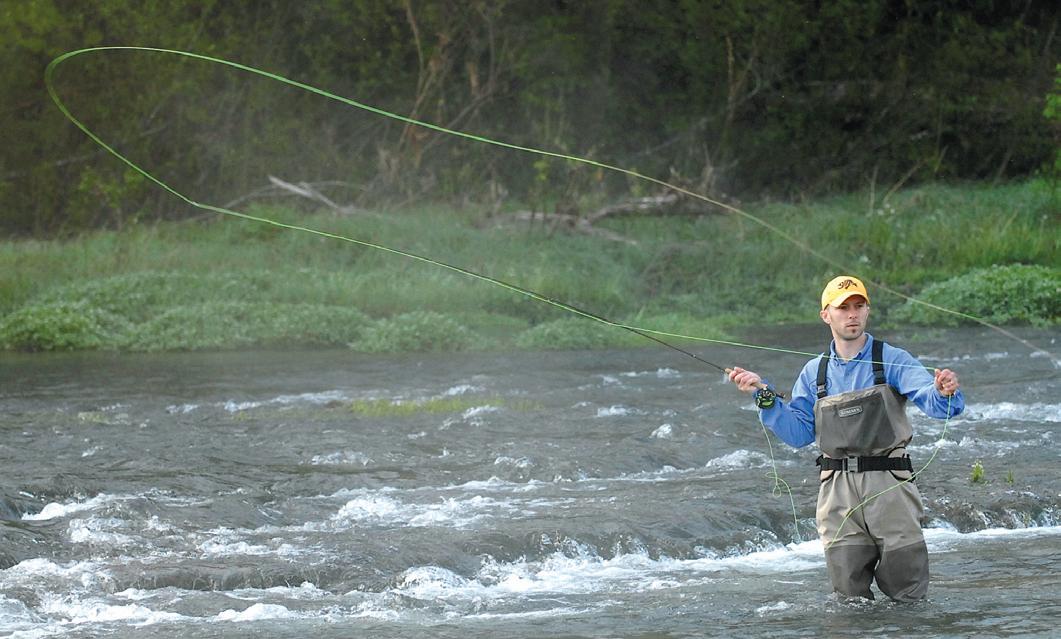







Include the Conservation Federation of Missouri in your estate plans.
Leave a legacy for the natural resources and traditions you have valued throughout your life. Make CFM a beneficiary of your will, trust, life insurance policy, or retirement plan. Any amount helps preserve Missouri’s resources and natural history for generations to come. What will your legacy be?
Call 573-634-2322 to find out more information.







